October 31, 2021
Martha O'Kennon
Rain. Sun. Rain. Rain. Sun. Rain. Rain. Rain. You get the idea...
Here is Jadesy, still sitting in the rain and cold. Picture two asks the question, "Is this thing down in between two leaf lobes a leaf bud or a flower bud?" I am afraid it is only a leaf bud. Third is a picture from last week of the Euonymus beginning to turn its characteristic red.
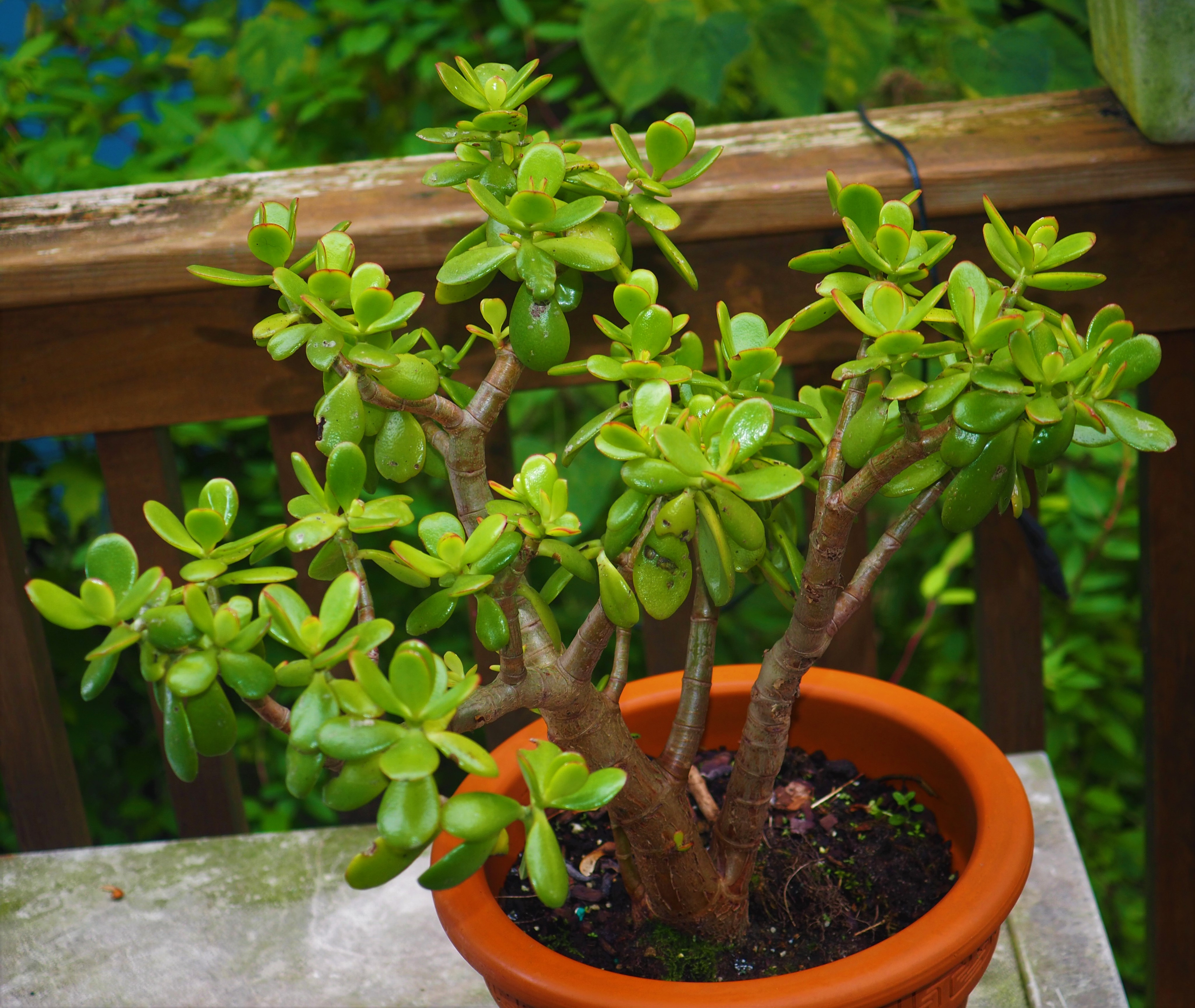
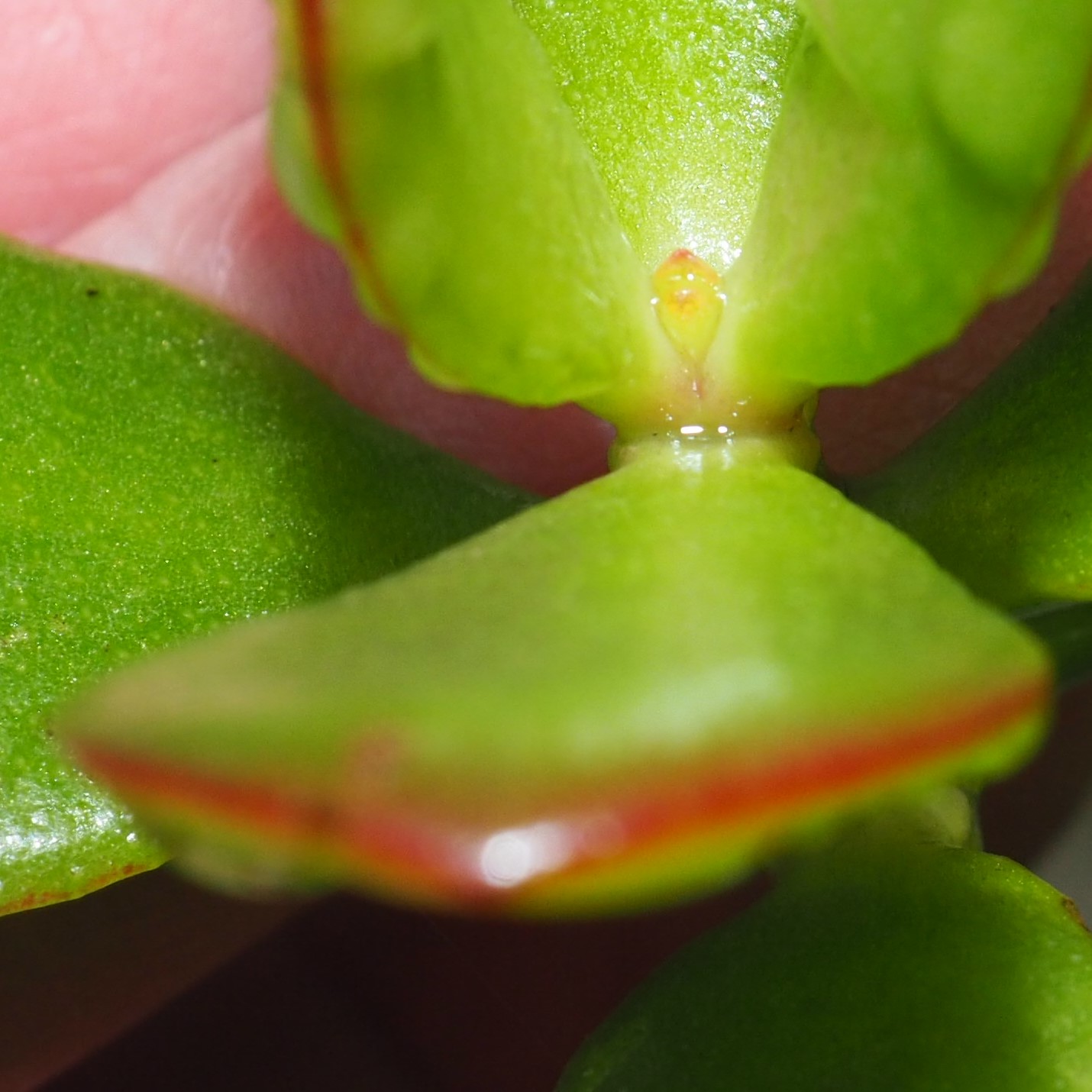
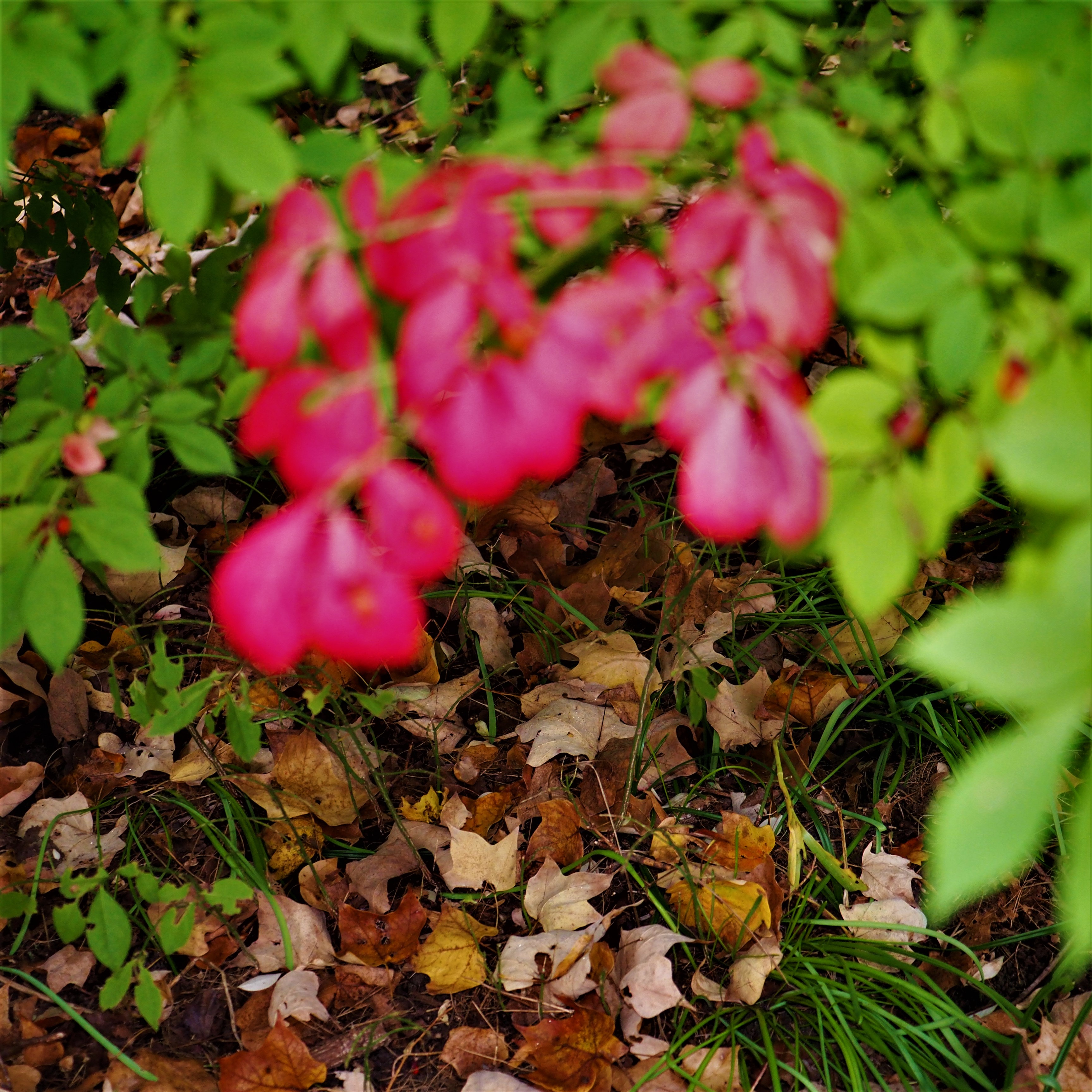
Remember that there is information in the name of the file for each image. You can see it by mousing over the
image - look at the lower left of the screen. Or you can click on the image to get to the (usually) larger image.
Then the info is displayed in the address line above. Sometimes the second click will actually display a
different view of the original image.
The Ants are harder to find and especially hard to identify. This first is a Small Honey Ant - the easiest kind to find on the Walls these days. But wait! Luckily after all that rain, this extra little Small Honey Ant appeared on the wall at the last moment to be included in this week's array. It took advantage of al that rain and it certainly can hold a lot more water than some of its older friends. Isn't this next one a kind of Ant too? No. It is a Long-palped Ant-mimic Sac Spider that we saw on October 11. Ant-mimic means capable of making you and me think it's an Ant. It caught me a couple of weeks ago.
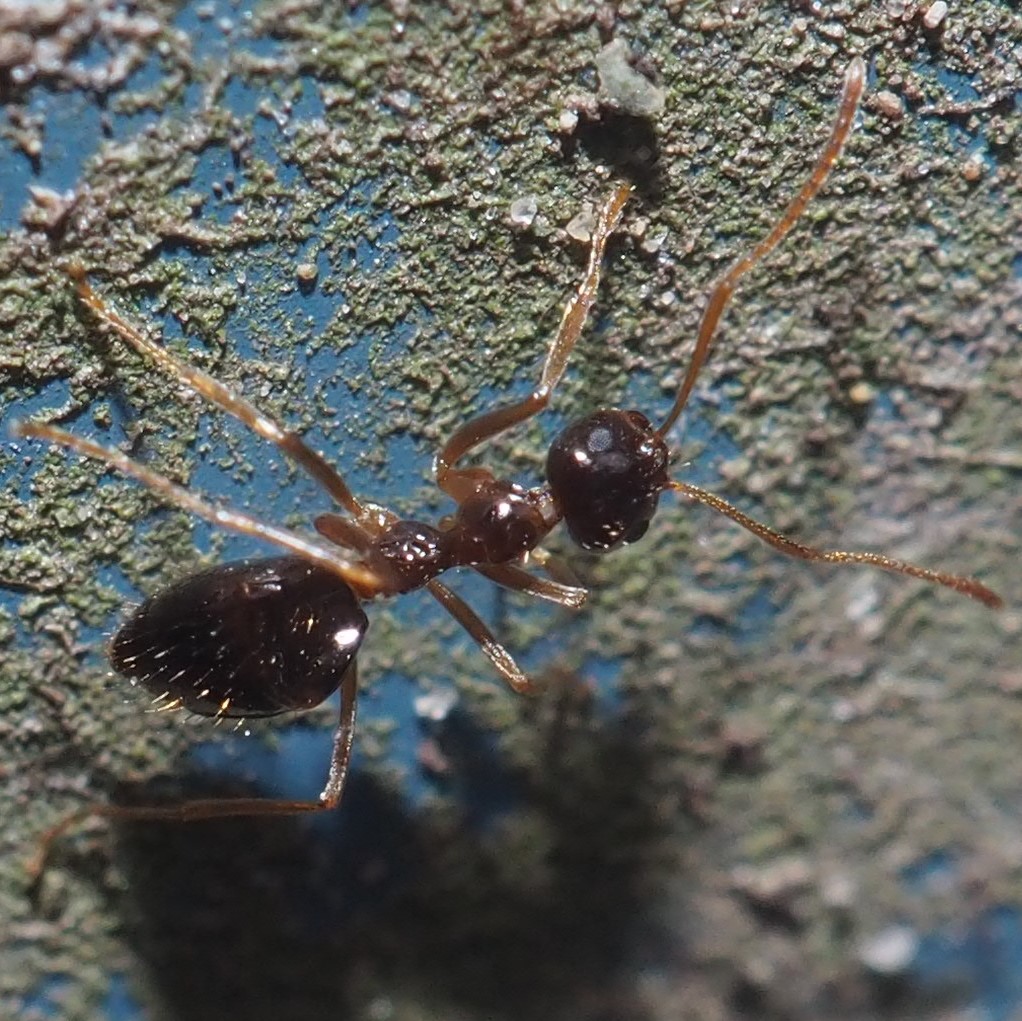
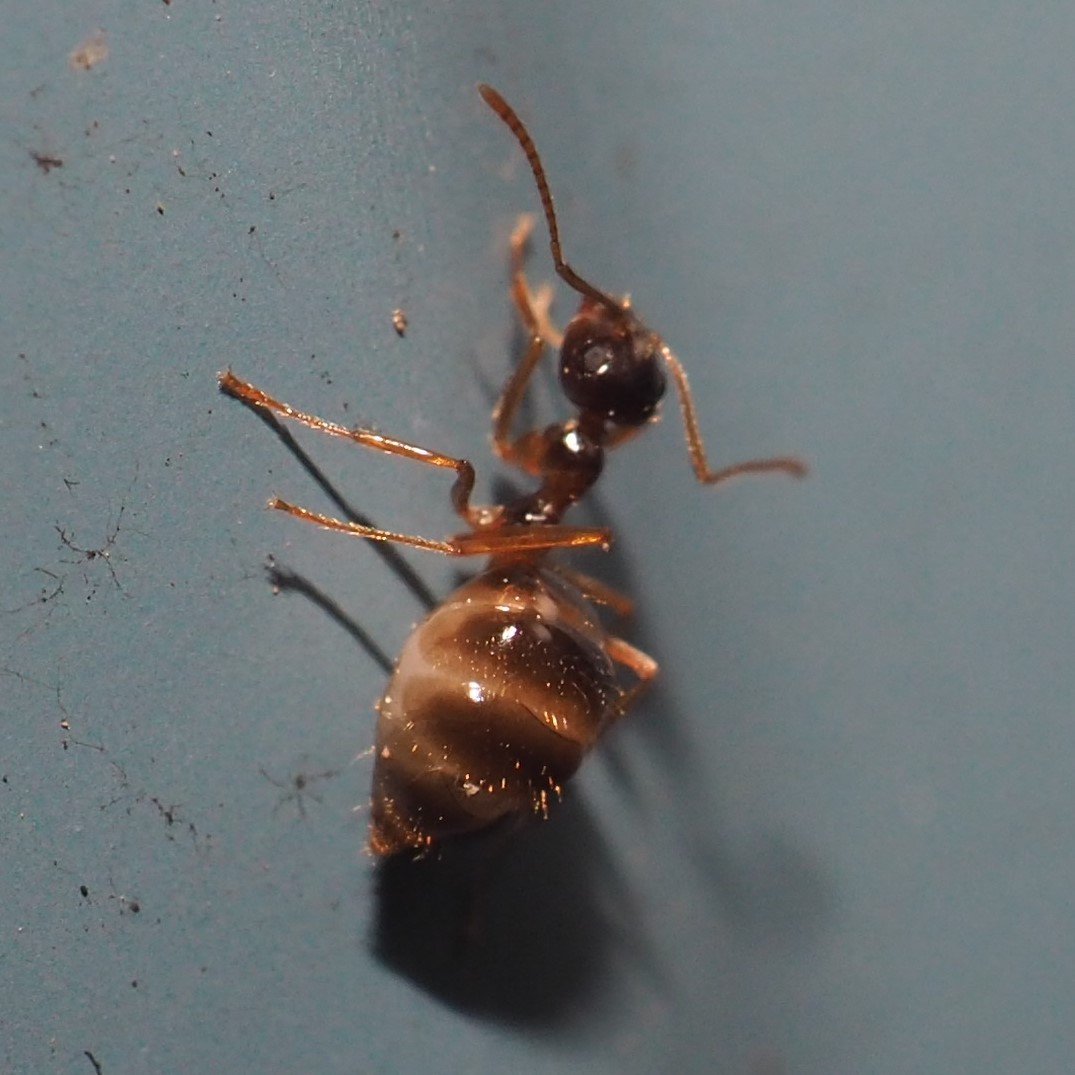

The Barklice are always plotting to surprise me. Here are two sets of Graphopsocus cruciatus eggs laid on the South Wall, then an Adult.
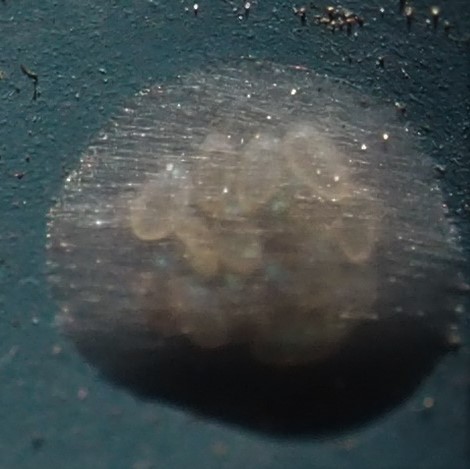
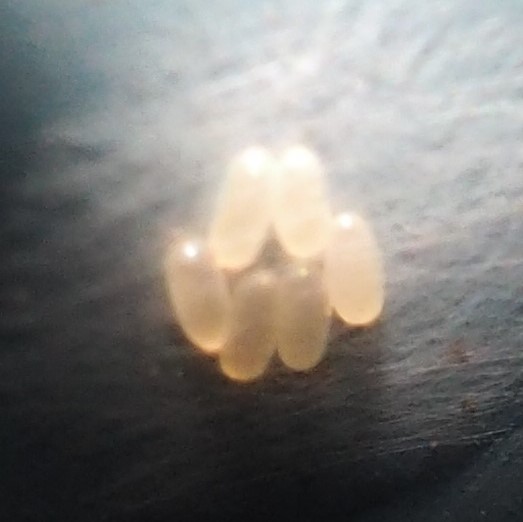
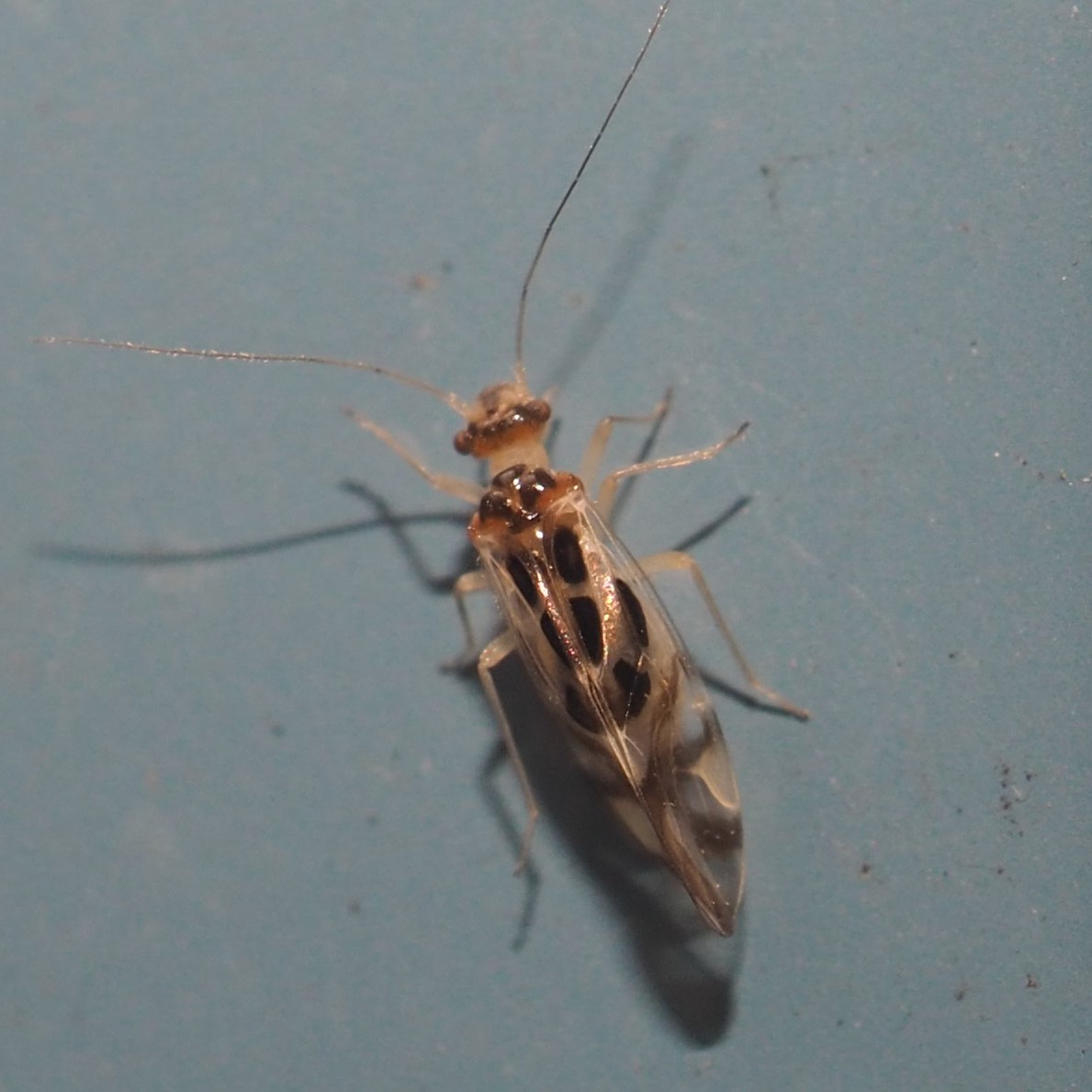
Here is an oddity: it seems that a batch of eggs in a web have hatched out to some strange form more like larvae than nymphs. Picture 2 shows a Graphopsocus cruciatus nymph. I've no clue what the "strange forms" will turn out to be.


Here are a Valenzuela [flavidus] adult and a nymph. Then a surprising Valenzuela with yellow eyes. But wait. Compare this "Valenzuela" with a Barklouse we saw last year - a yellow-eyed more nearly whitish-grey barklouse. Their venations look very similar. I think our "Valenzuela" is in fact Xanthocaecilius sommermanae.

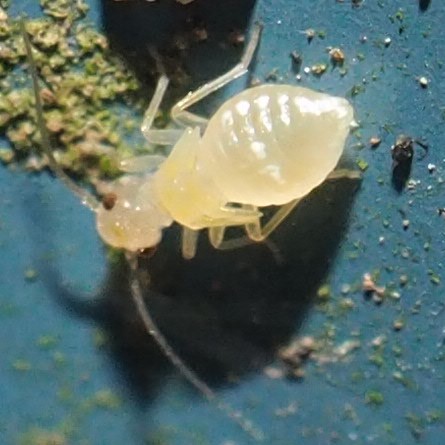
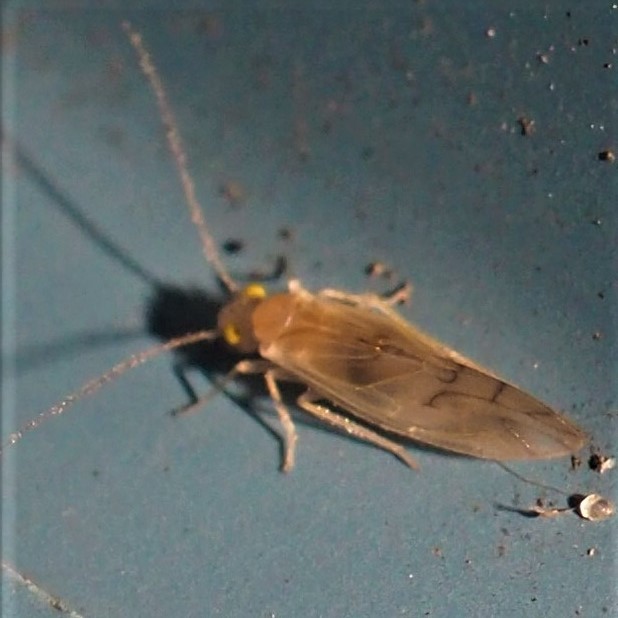

I didn't see Polypsocus nymphs or adults this week. There was ONE Echmepteryx hageni. Flash: look at picture 2: it looks as if it has the pterostigmata of a Psocus leidyi. But Diane Young, on seeing this part of the blog, says it is really Teliapsocus conterminus, something easily mistaken for P.leidyi. Then we also saw these two shots of Trichadenotecnum, maybe T. alexanderae. I don't know the other members of this genus but I'm sure this is genus Trichadenotecnum.
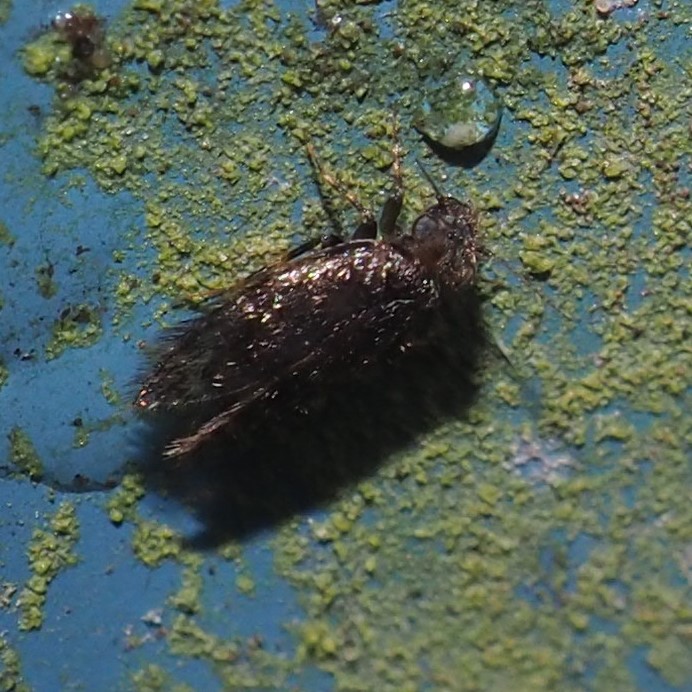
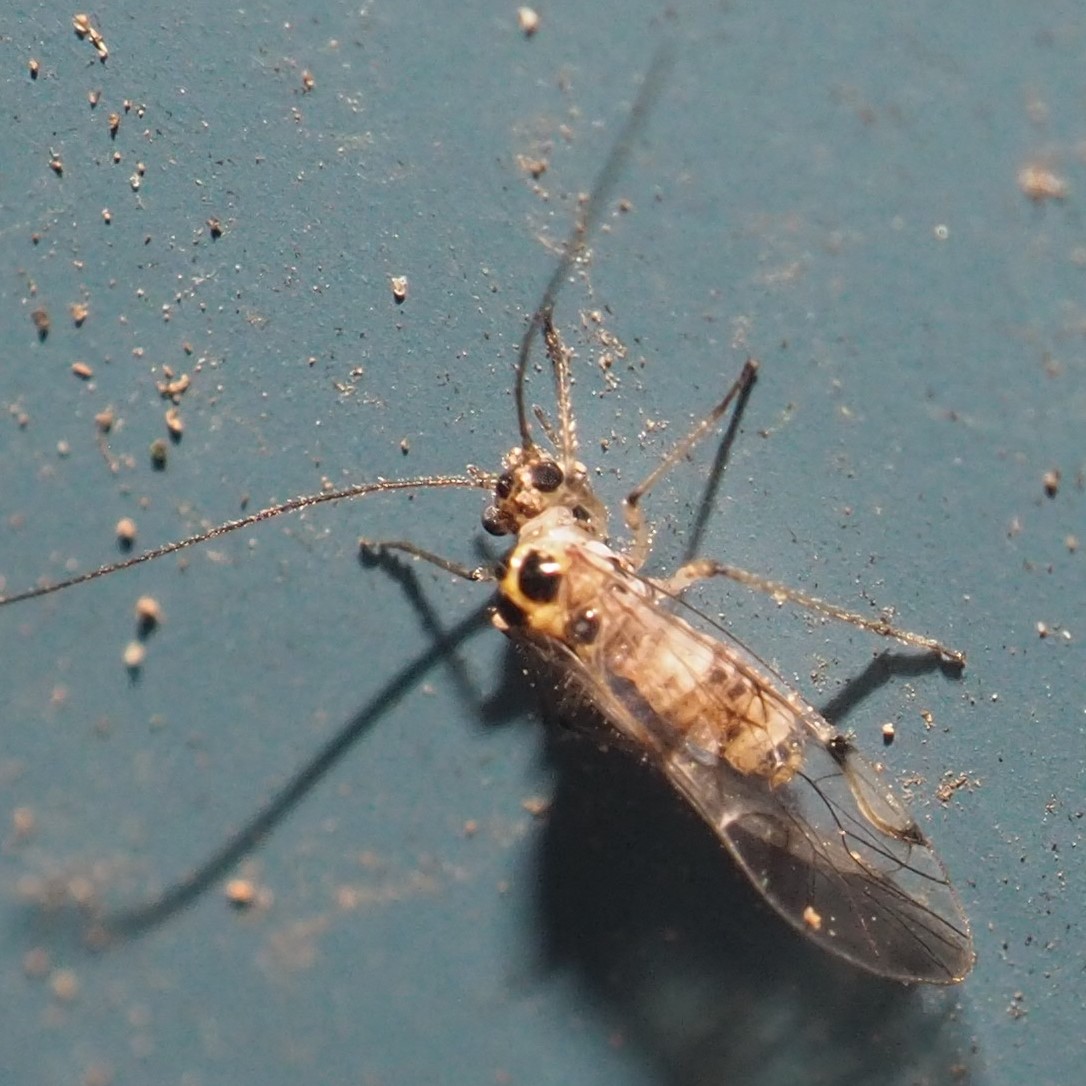
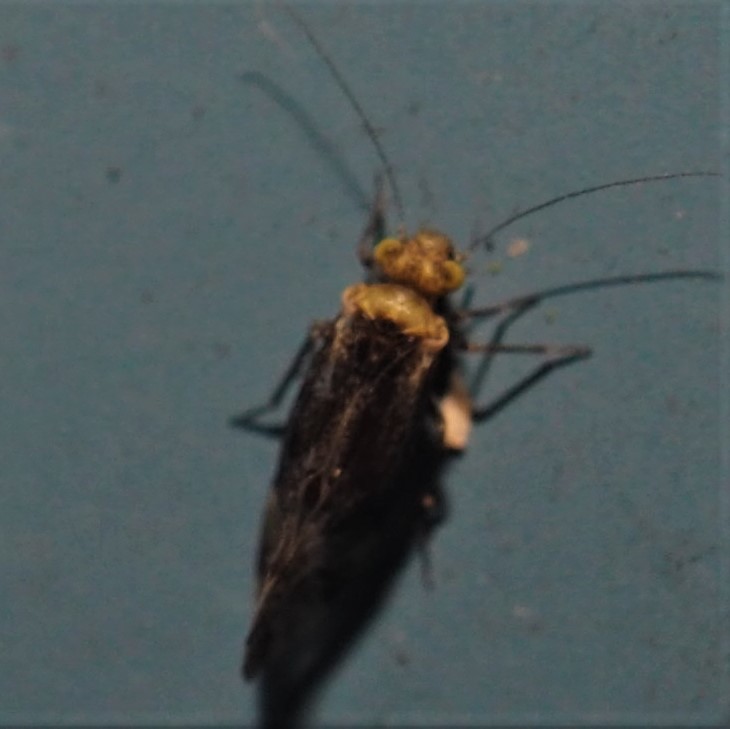
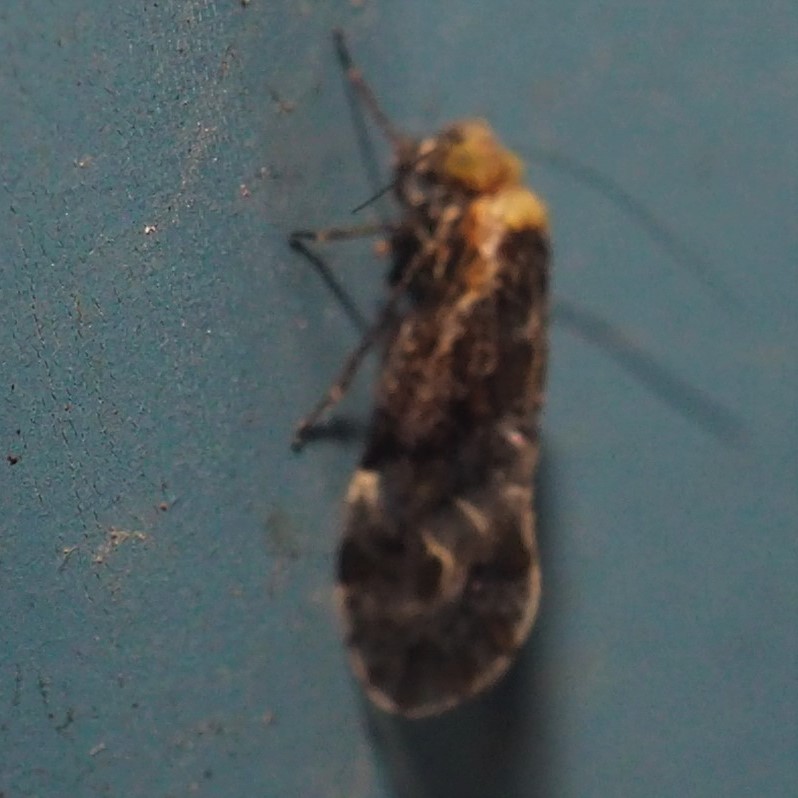
We didn't see much of the Ectopsocus meridionalis this week. But here is the slowly yielding egg field on panel 8 of the North Wall. And the strange kind of eggs on East 7 from south. We will have to watch and wait to try to answer some of the questions we've raised for ourselves!
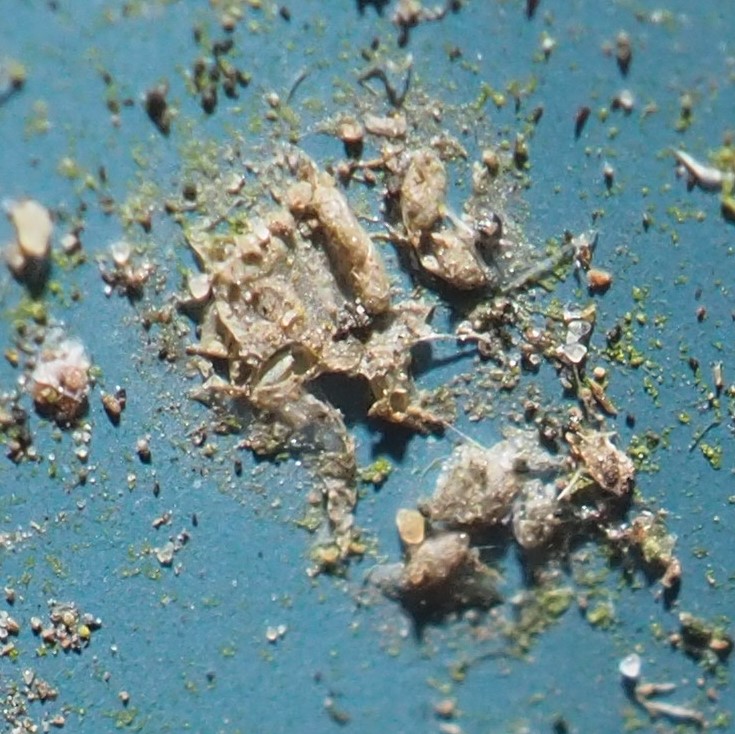
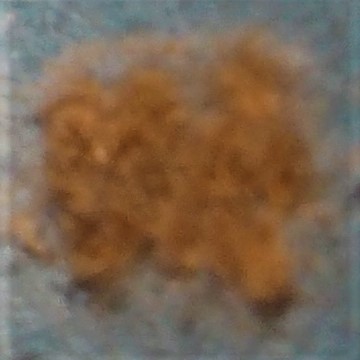
Here are some of the week's Beetles. First, an Asian Lady Beetle. in a very late-blooming Goldenrod spray. Then a Weevil which a Spider has caught. Finally - is this a Beetle or a Springtail or more mysterious beastie?
Answer: it is indeed an Elongated Springtail, and NOT a Beetle. I believe it is Tomocerus minor, which we have seen before.
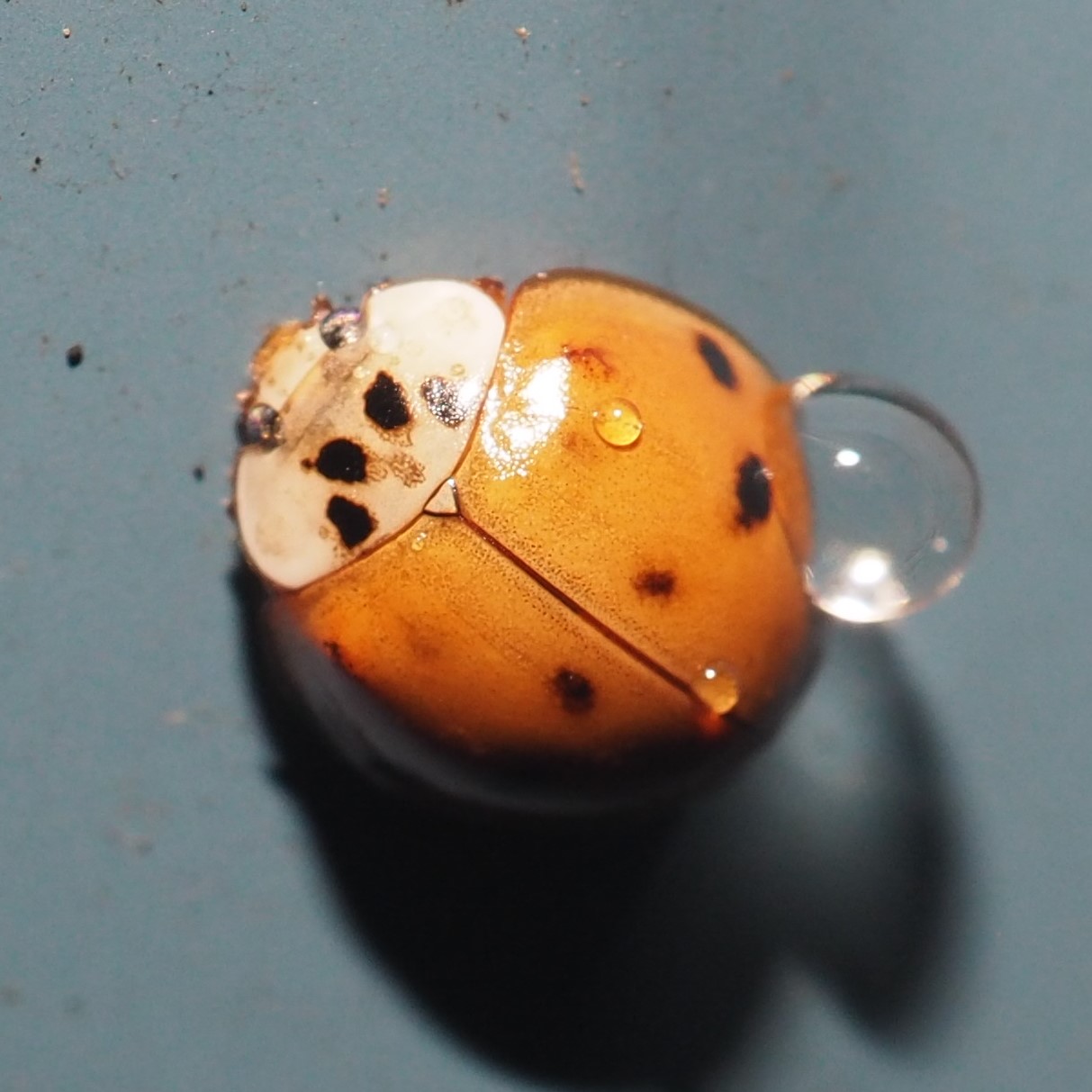
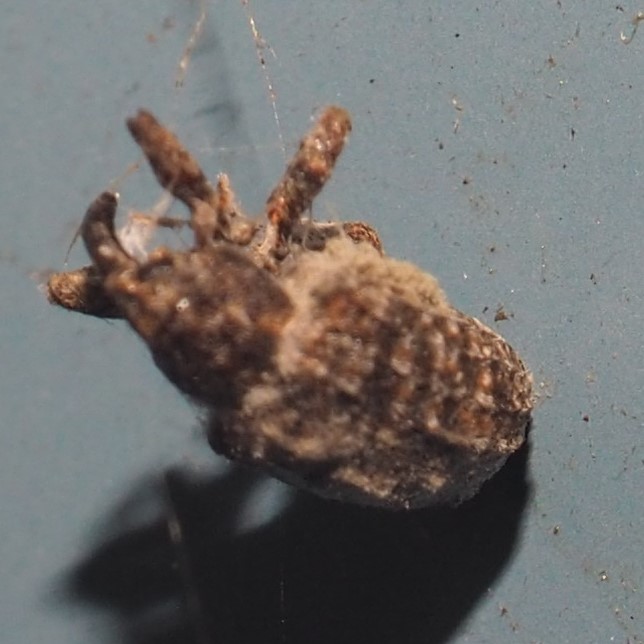
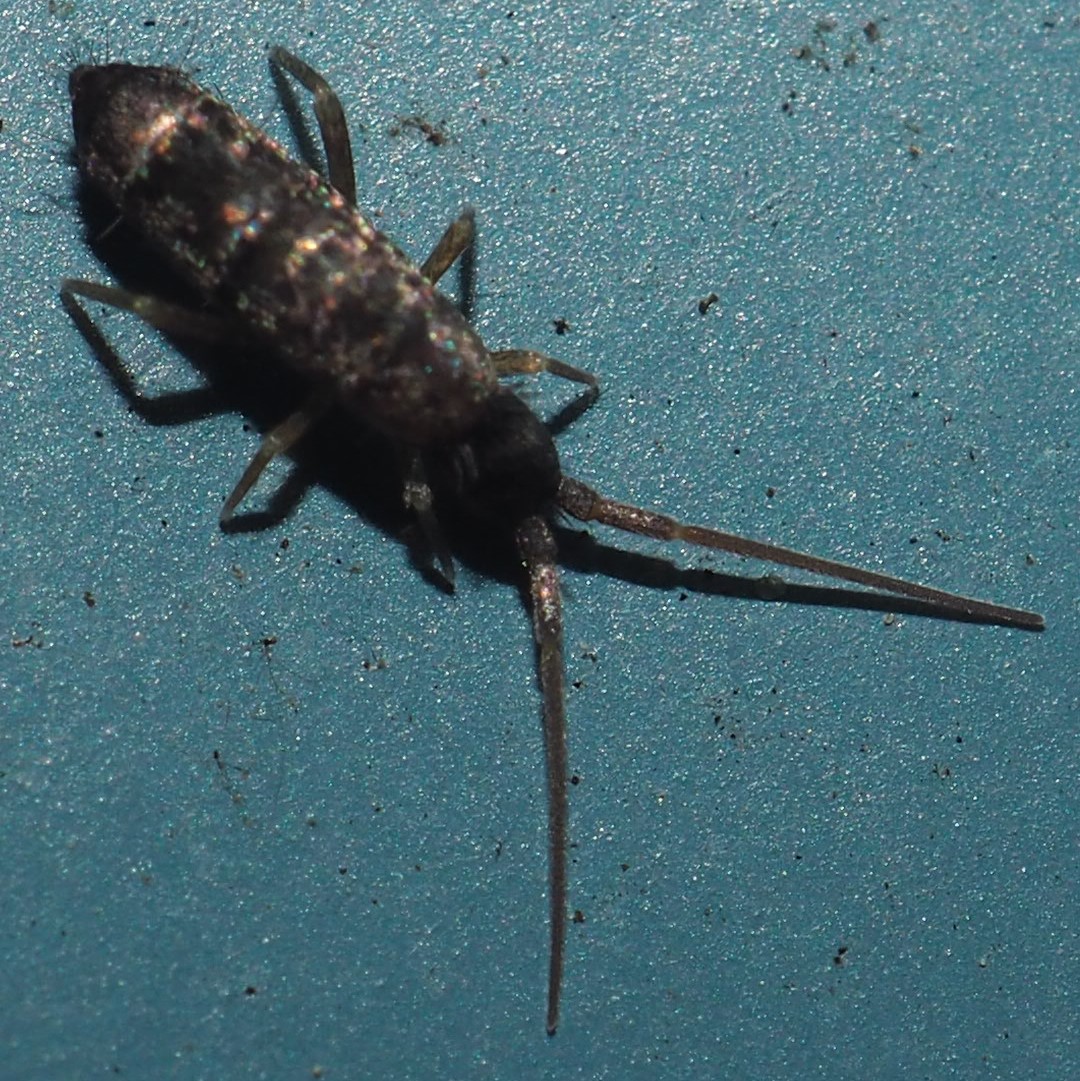
The dear little Assassin Bugs didn't show their probosces this week. But we had a surprising number of Leafhoppers. I heard it from eithe Solomon @nomolosx or Kyle @hopperdude215 that they overwinter as adults. So here are Erasmoneura vulnerata; a dotted form of Eratoneura; and the more usual form of the same genus.
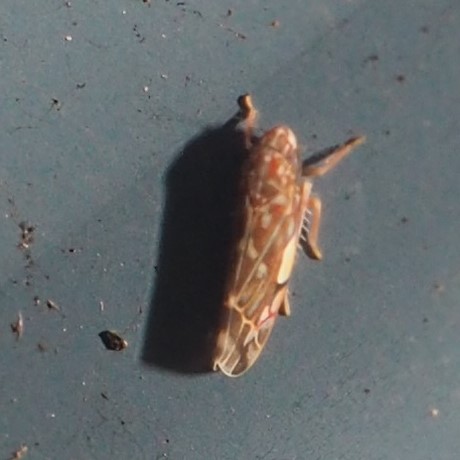
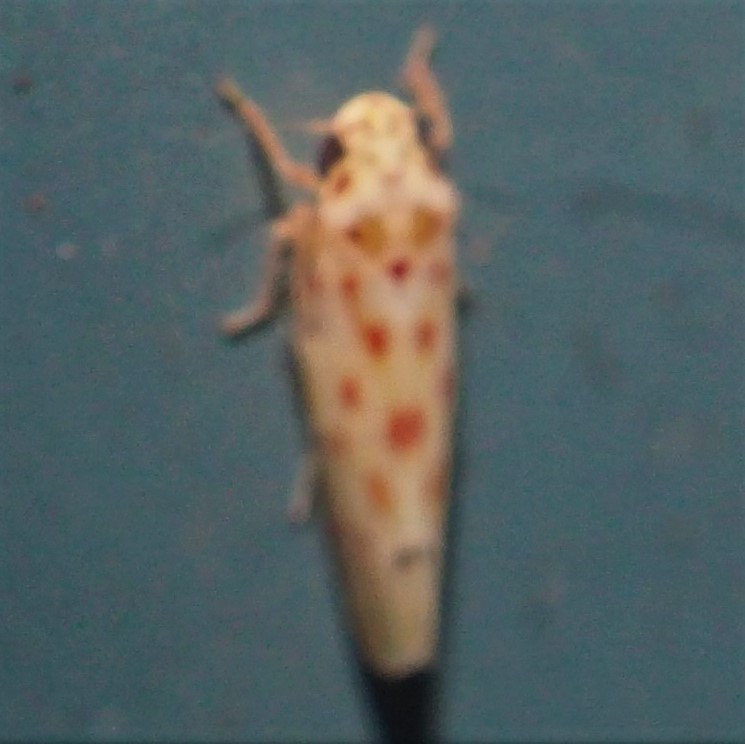

Here are a couple of cool species of Eratoneura. First is E. ardens and second E. affinis. Third is a hard-to-identify member of another genus..
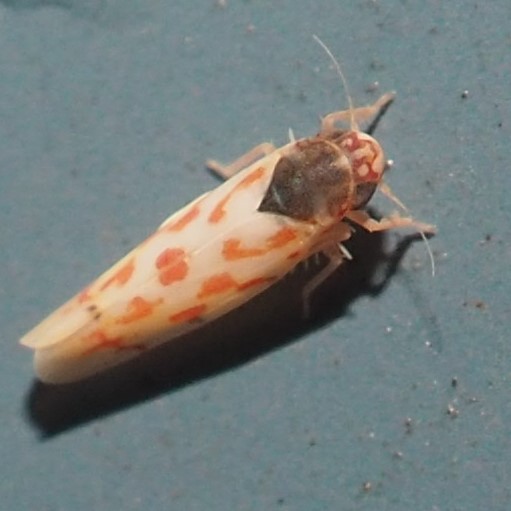
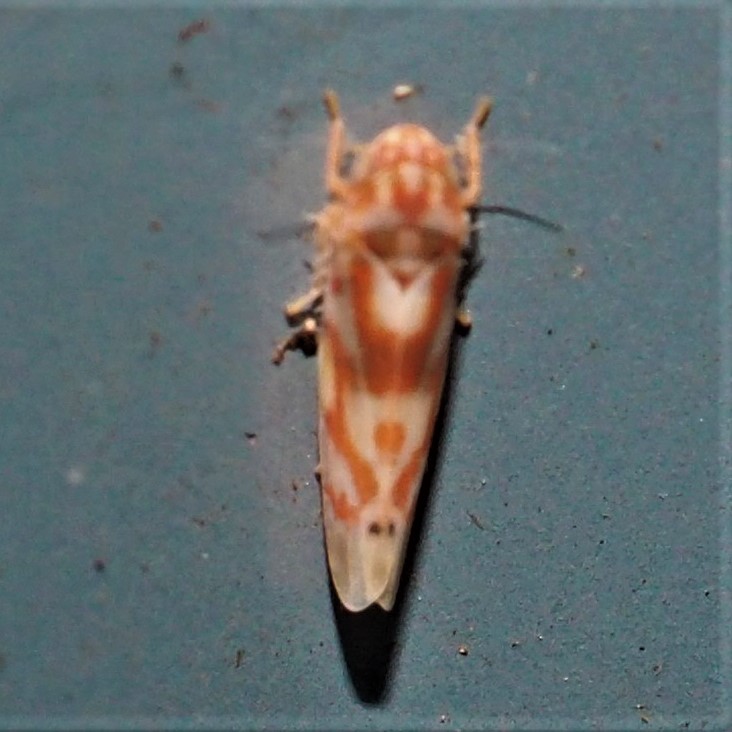
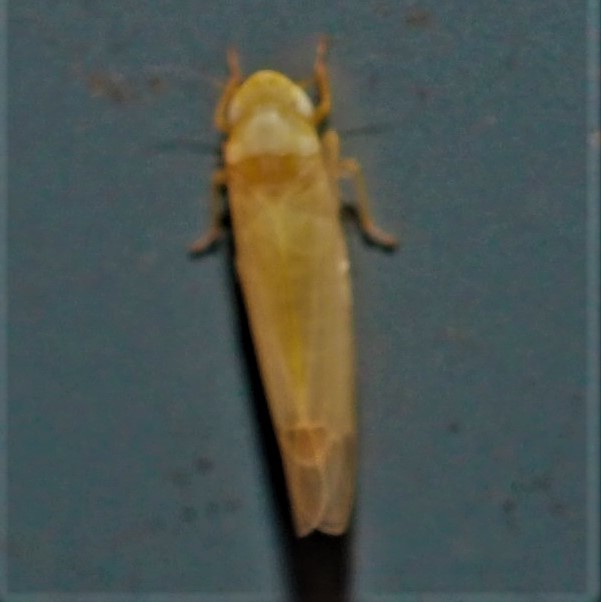
First here is an exemplar of a very common Genus, Erythridula, which used to be called Arboridia. The second is a variation (but not a new species) of this Genus. Third is also just a variation, not a new species. Last is Erythroneura infuscata, which is even fuzzier than usual. Maybe it was standing in a puddle when I shot it.

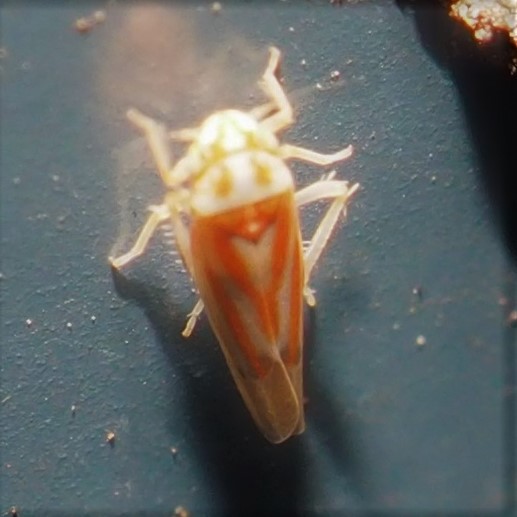
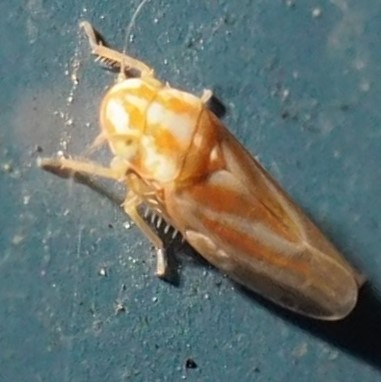
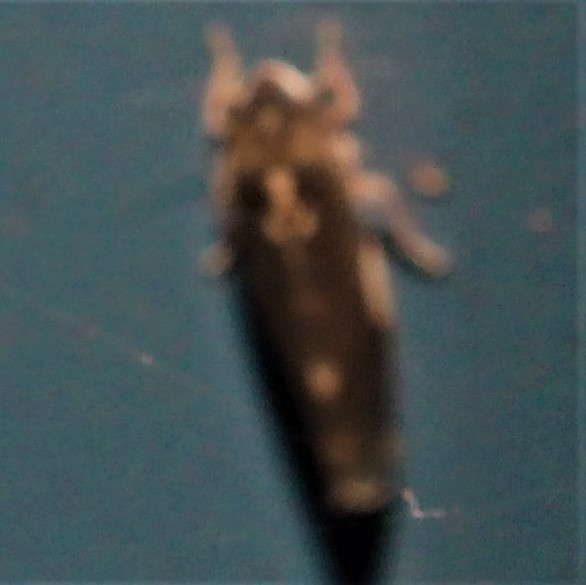
Here is a bug not adored by Americans in small towns all over the country. This Eastern Boxelder Bug does try to push itself in between clapboards to keep warm for the winter. I think they're lovely (and yes, I do have wooden clapboard covering my house's frame). Picture 2 is a reminder of the Drymus unus "Dirt-colored Seed Bug" that appears here when the Goldenrod is dying out for the year. Now, here is a quiz question: What do pictures 3 and 4 have to do with the brown and black D. unus in picture 2? Answer: Our friend @jeanfrancoisroch of iNat says they are the same bug, probably with their plainer black and brown colors being morphed into more subtle (and to me more intriguing) reddish hues.
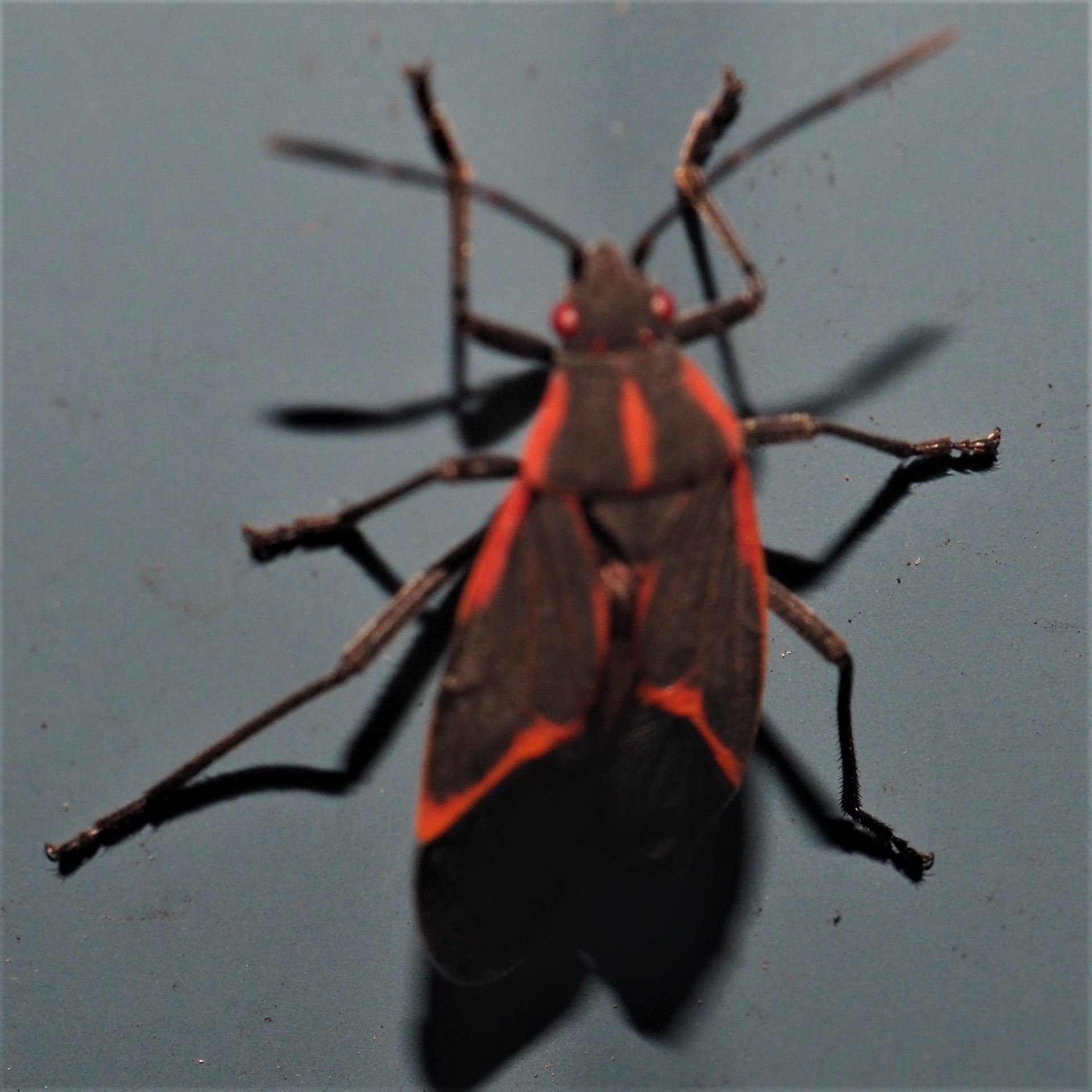
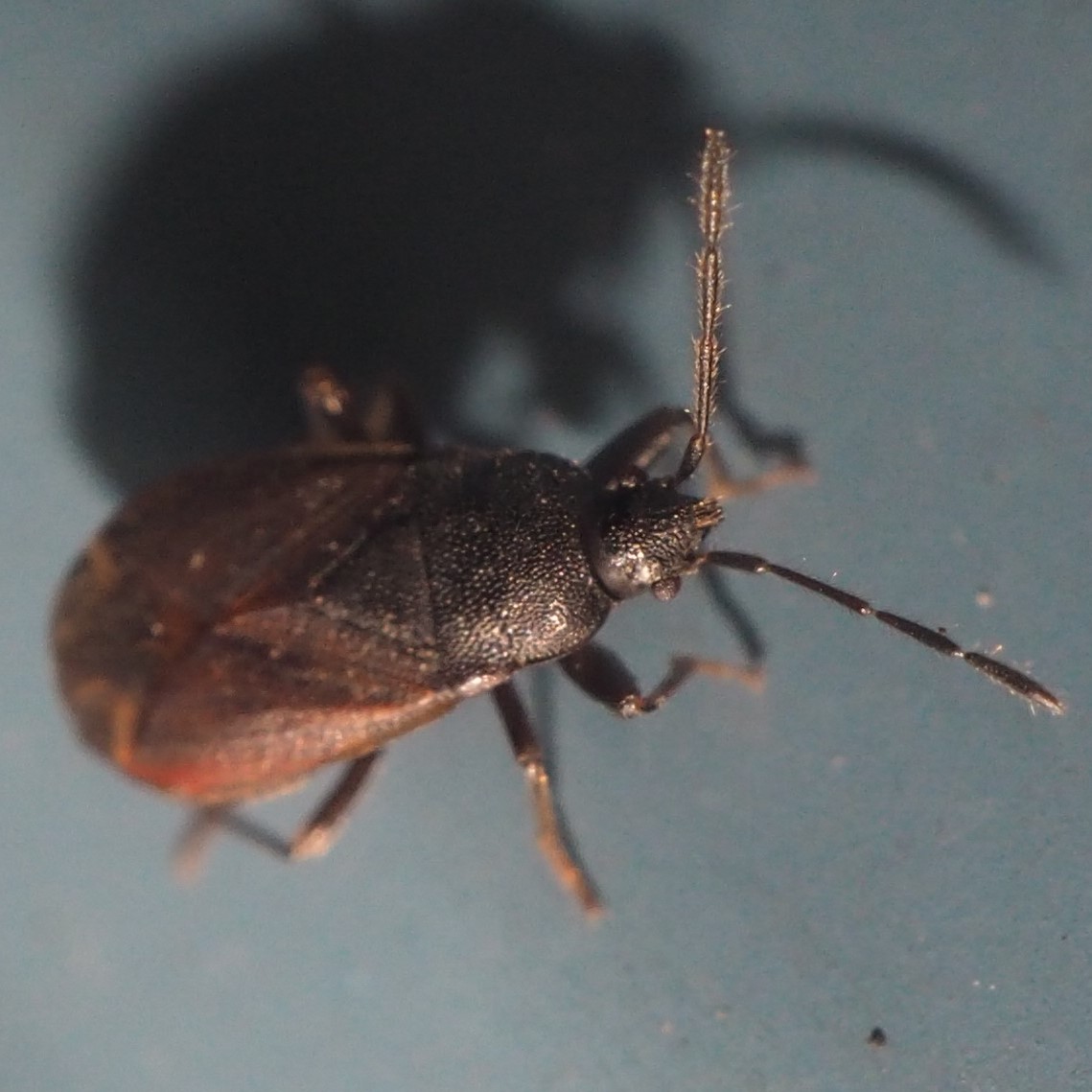

Picture 1 here is another of those Leafhopper Nymphs that we watched run all over the place last week. This one actually jumped from view while I was trying to get a motion gif of it. Second is a Hackberry Pachypsylla (thick psyllid), a relation of the Leafhoppers, but called a Psylloid. This one lays its eggs on the Hackberry bushes on the Albion College Quad, according to Dan Skean, Emeritus Prof, just retired from the College. The nymphs cause galls on Hackberry. Third is a European Earwig. And I didn't lie when I wrote that we had had no Assassin Bugs. I just didn't see it until I went out yesterday to see if there were a few more things to add to the blog. And there it was - not our usual greenish red-eyed Zelus luridus, but the less common one to see - Zelus tetracanthus, the Four-spurred Assassin Bug. A nymph, but an Assassin already.
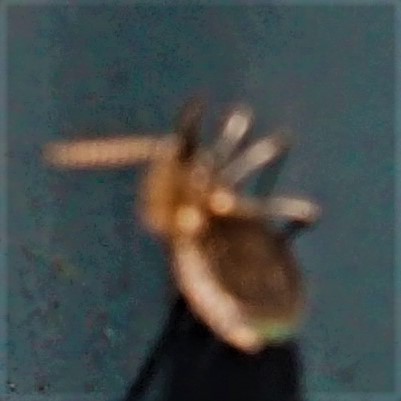
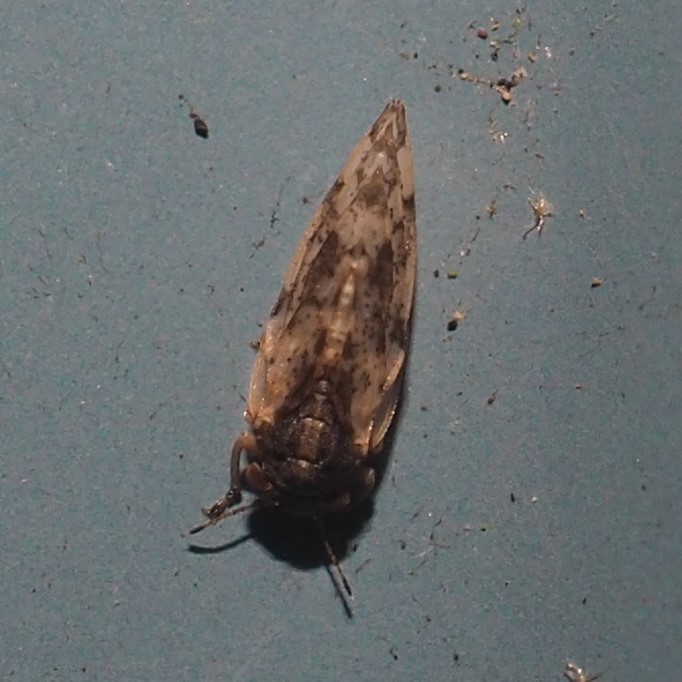
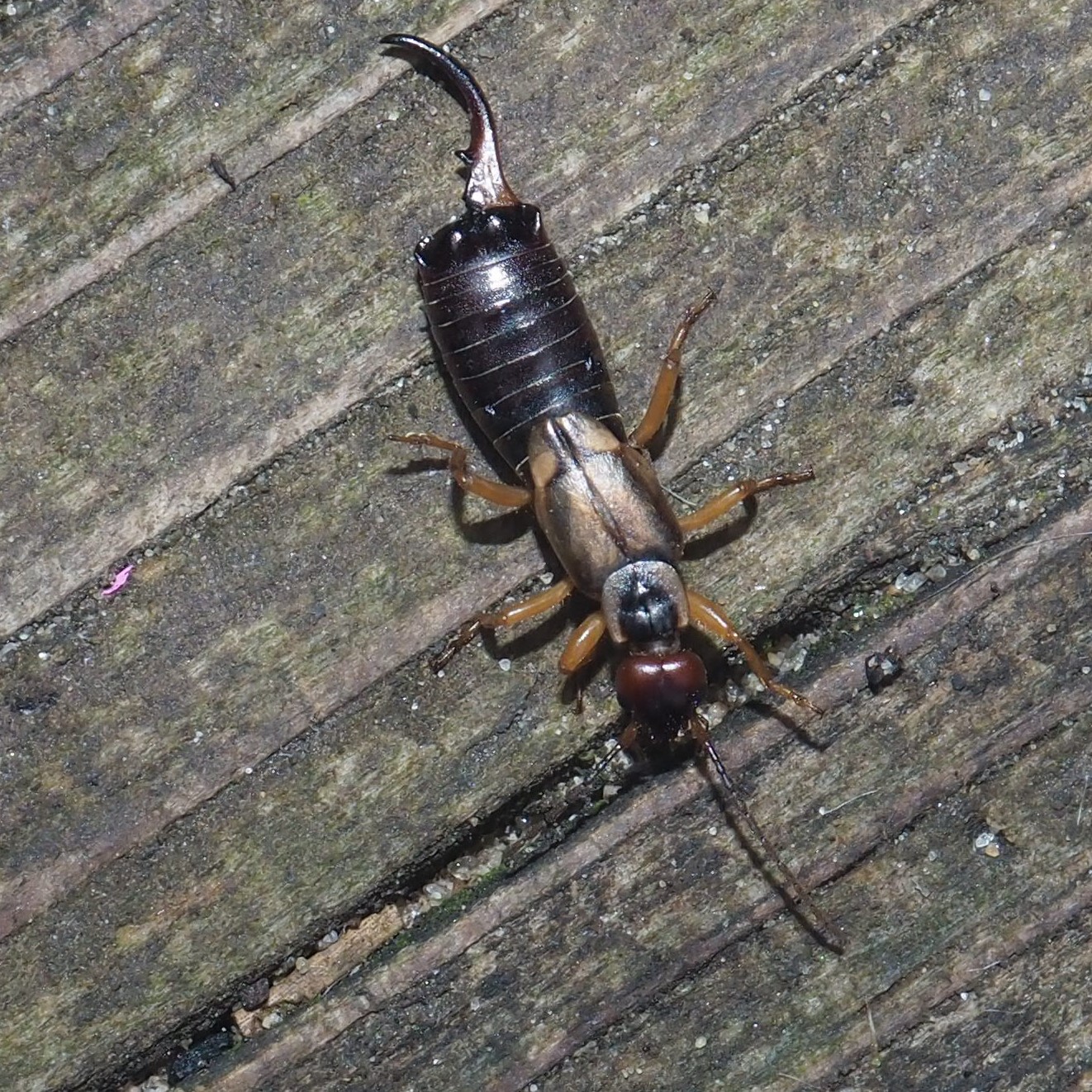
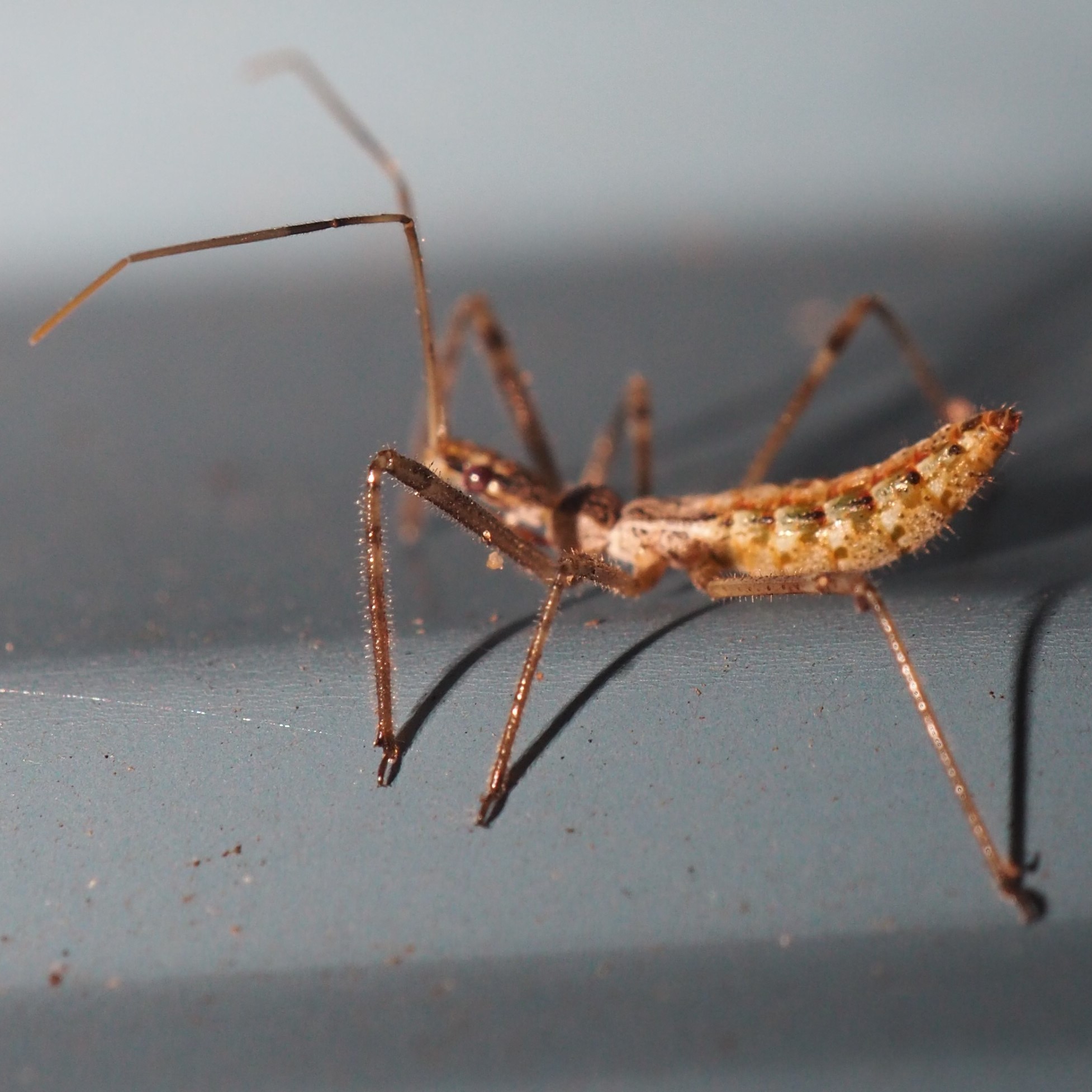
Now to the Flies! Here are two Crane Flies. Last is Asteia beata, which I also saw in April 2020 and in December 2018.
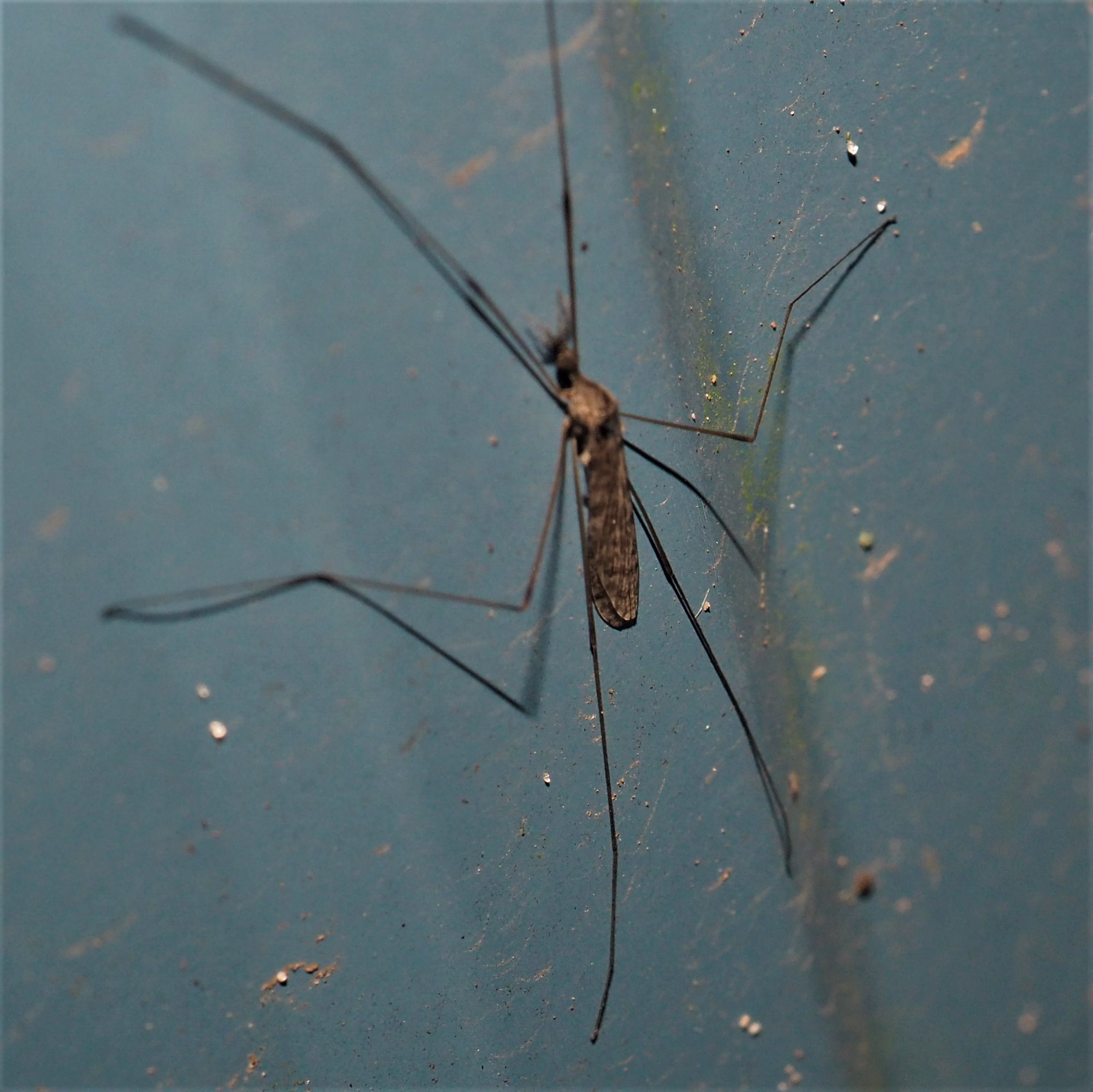
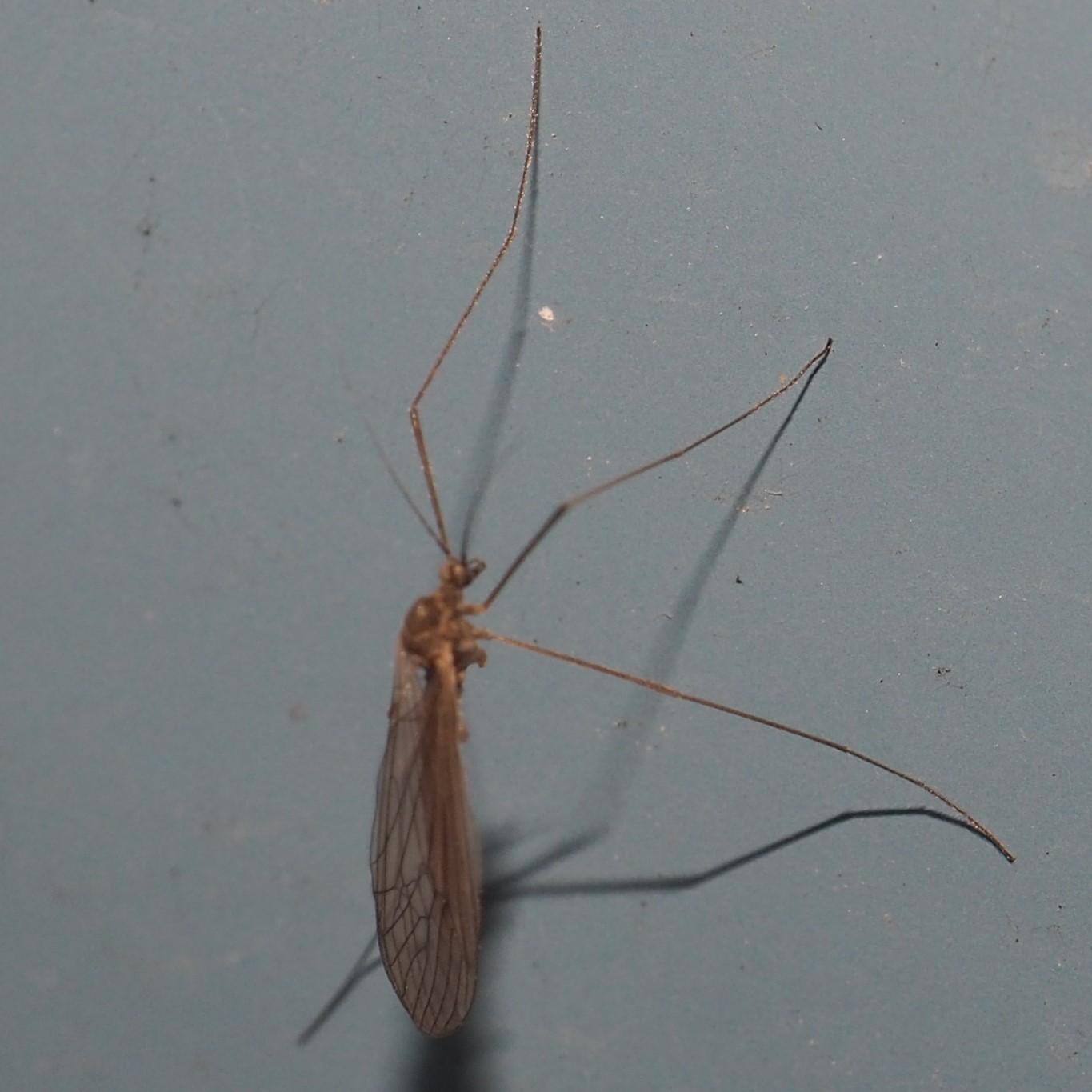

First, here is a big rough-looking Fly. Then an Asian Bush Mosquito. You can see it has a big blood-sucking proboscis. Third is an enlargement of that Asian Bush Mosquito, showing its genus Aedes' spotted legs.
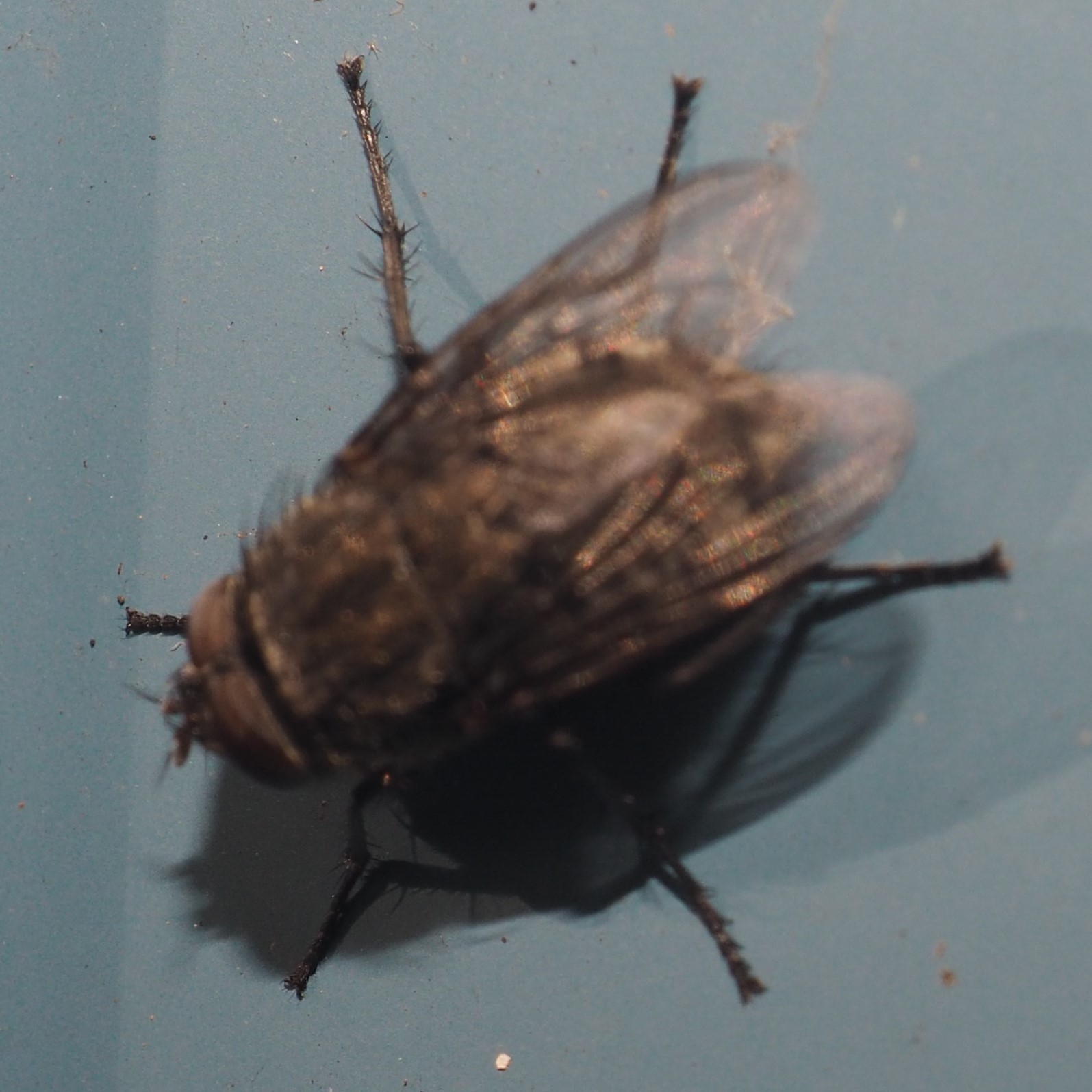
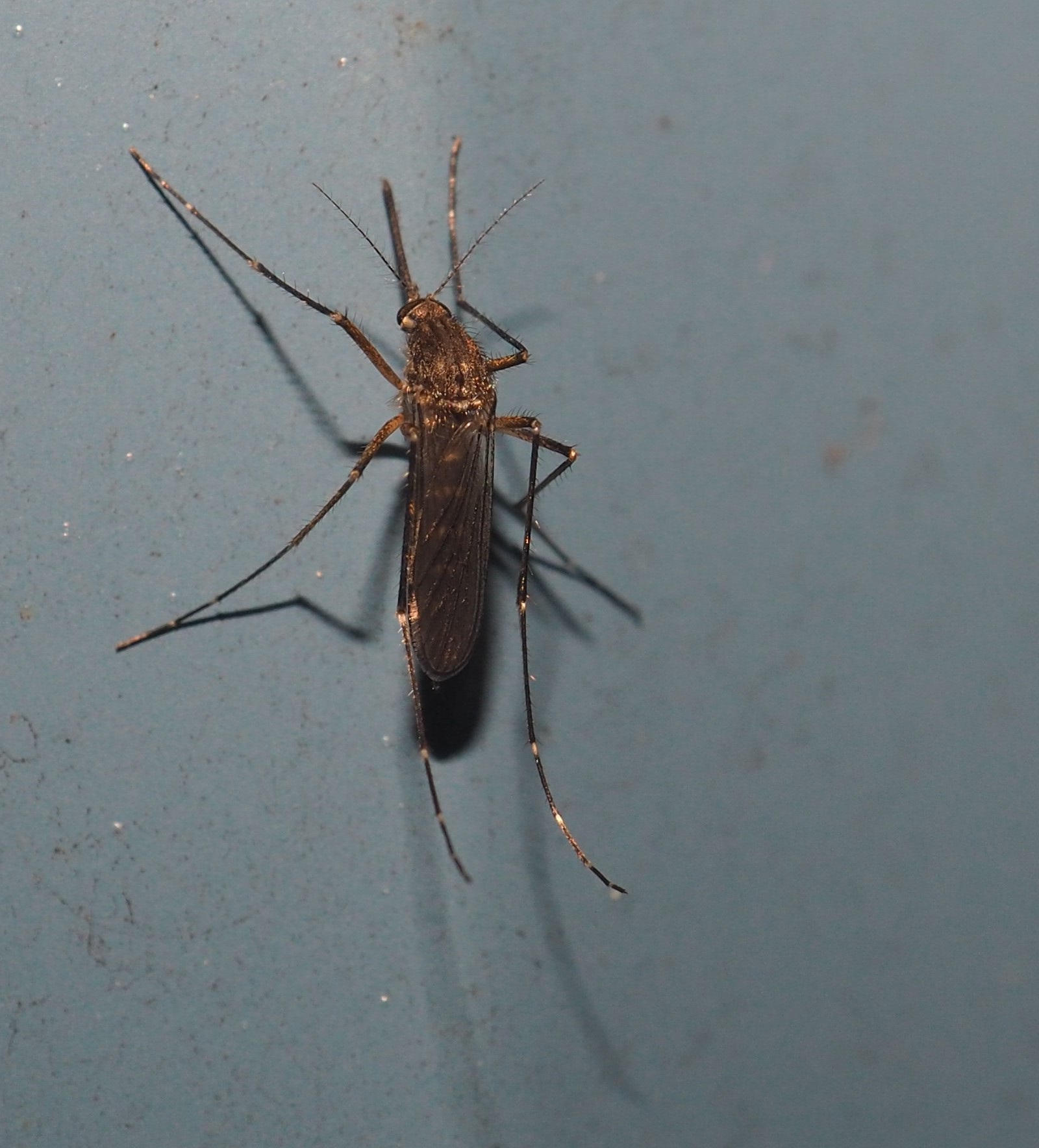
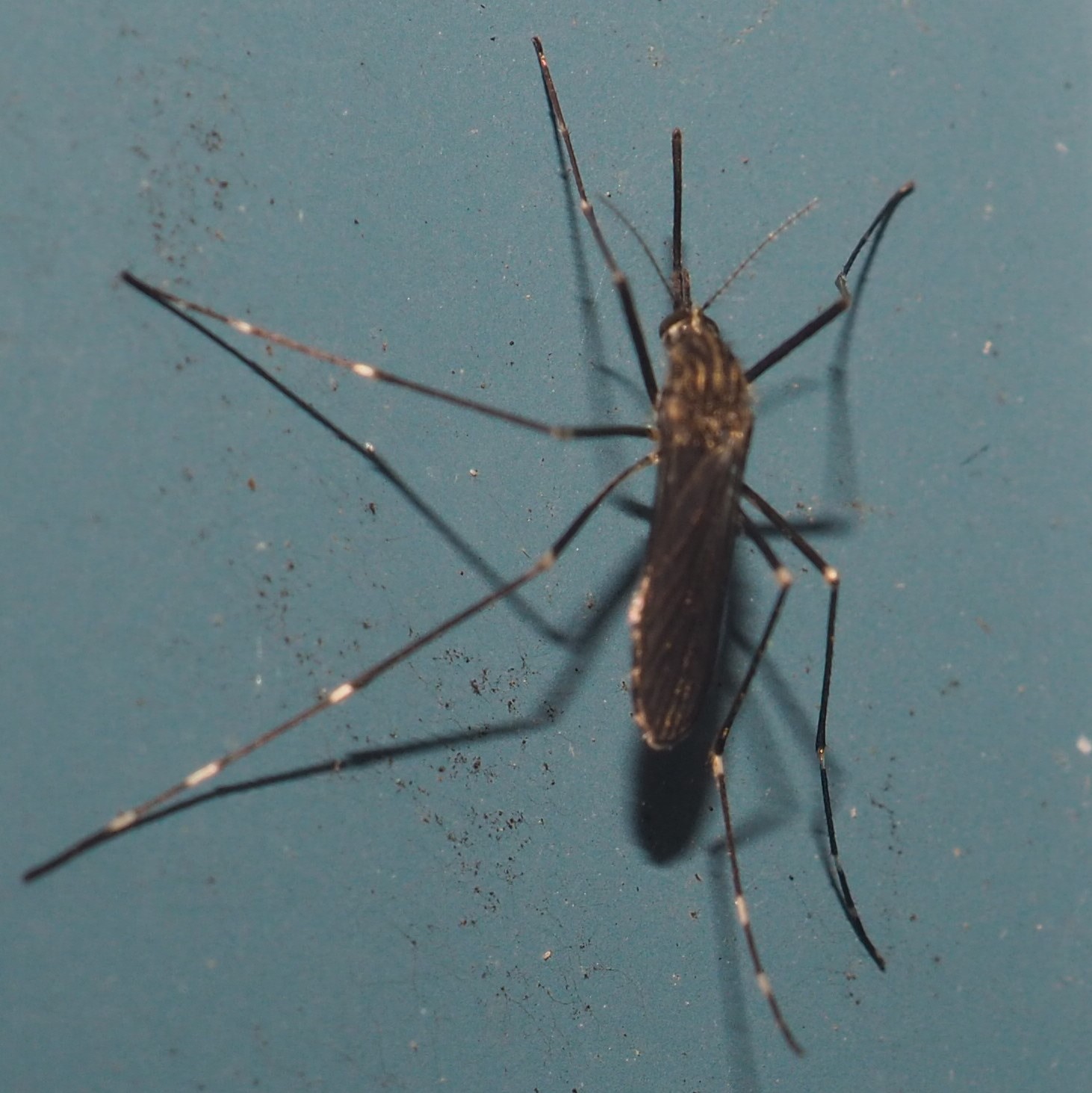
Next is another real Mosquito, Anopheles punctipennis (spotted wings). Perhaps you said, "Oh look! A male Mosquito - look at those creative palps and antennae. Liam Woolf (@ospr3y on iNat) explained that
"Palps specifically are chemosensory, so larger palps may help them find food and mates. Fuzzier antennae help them tune in to the frequency of female’s wingbeats." It really is all about sex! The second picture shows a better view of this equipment. Picture 3 is of a Mosquito of genus Culex.
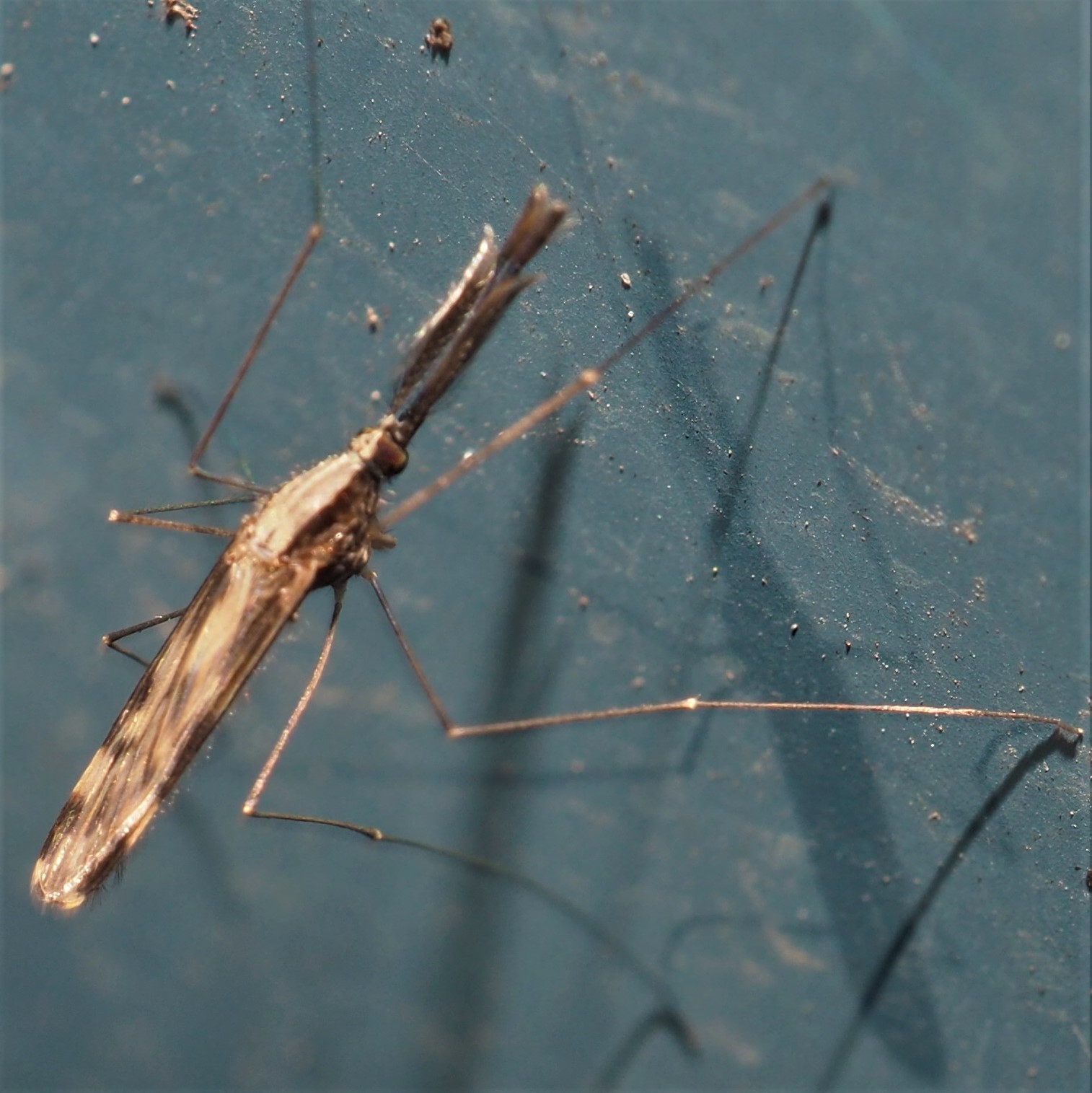
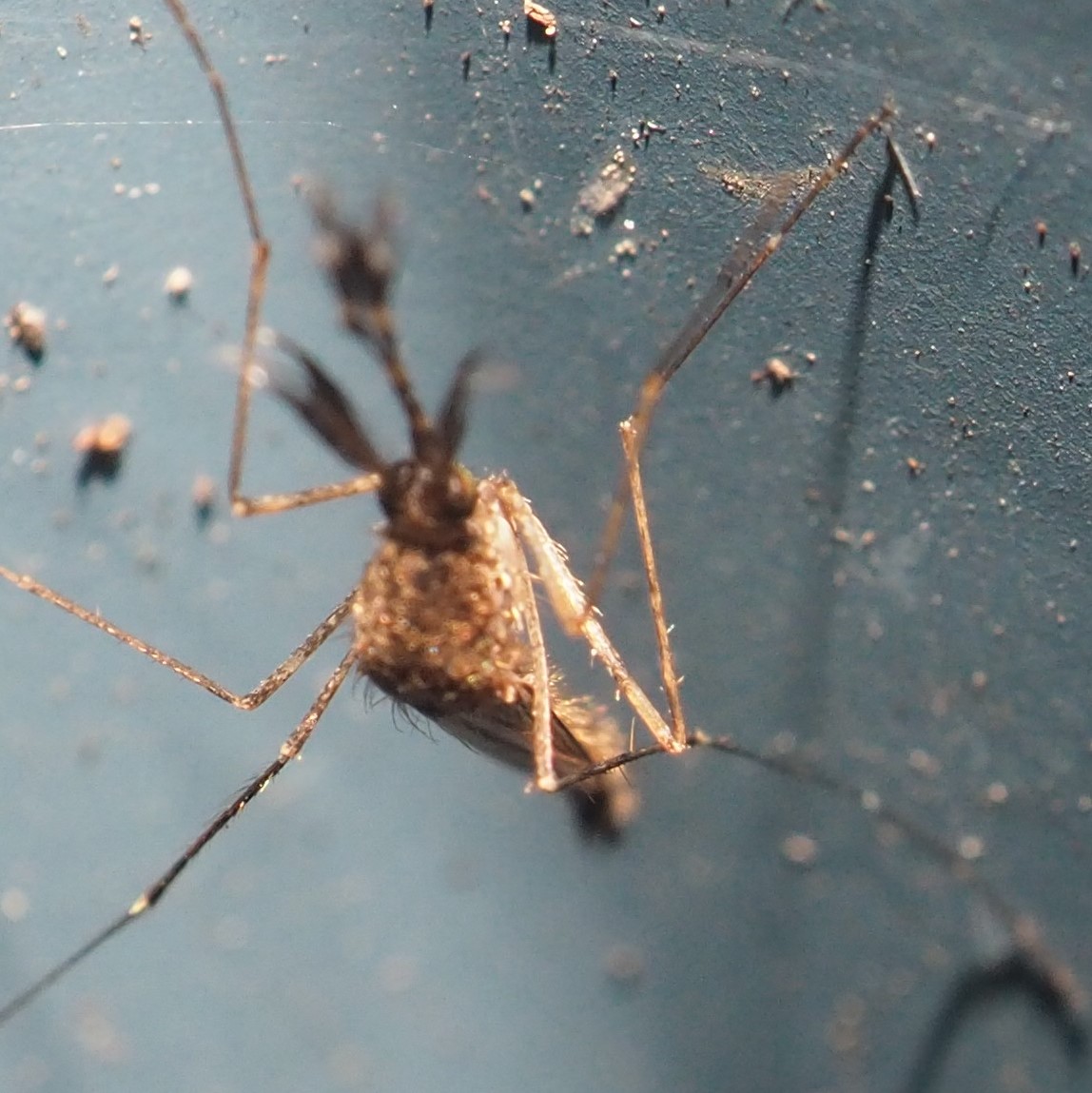
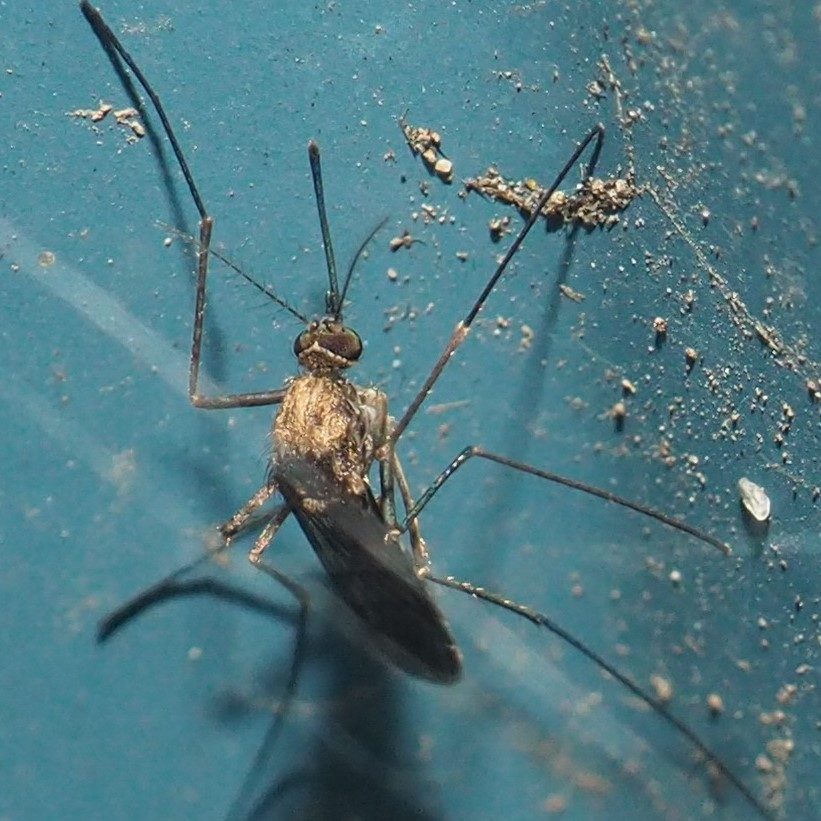
Pictures 1 and 2 show a couple of different kinds of Fungus Gnats. Note the spiky legs. Third is probably another species of Fungus Gnat.
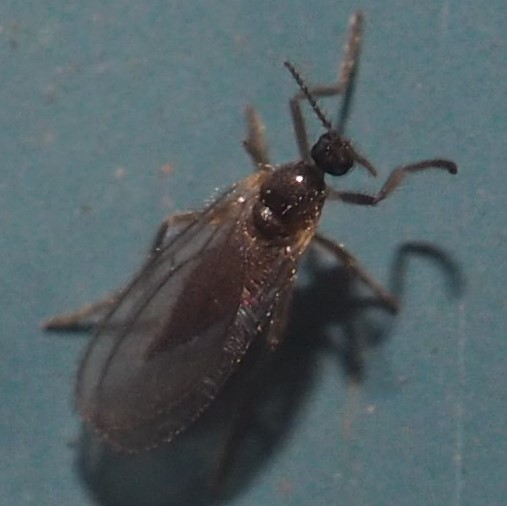
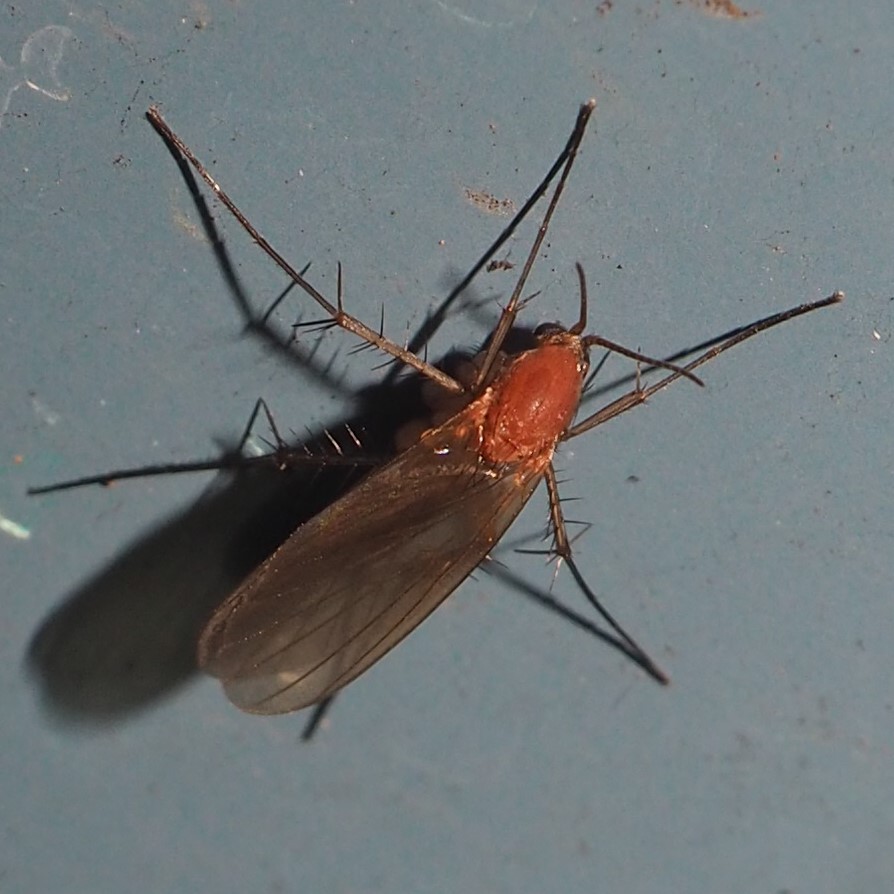
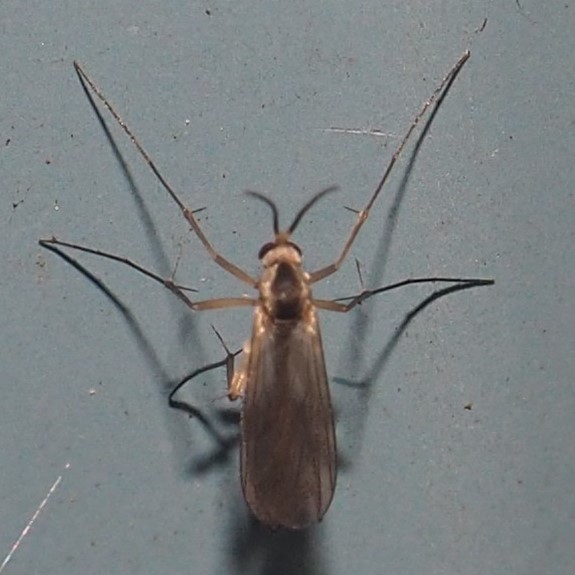
Here is another mystery Fly. The iNat ID app said Subfamily Oscinellinae, but I have had trouble matching these photos with any particular genus or species.
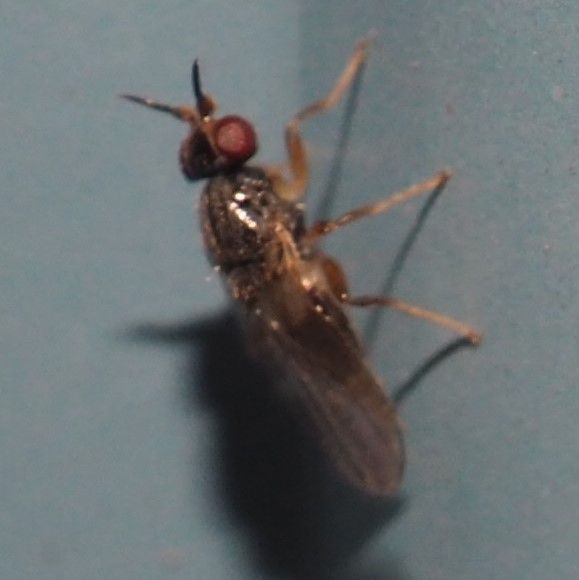
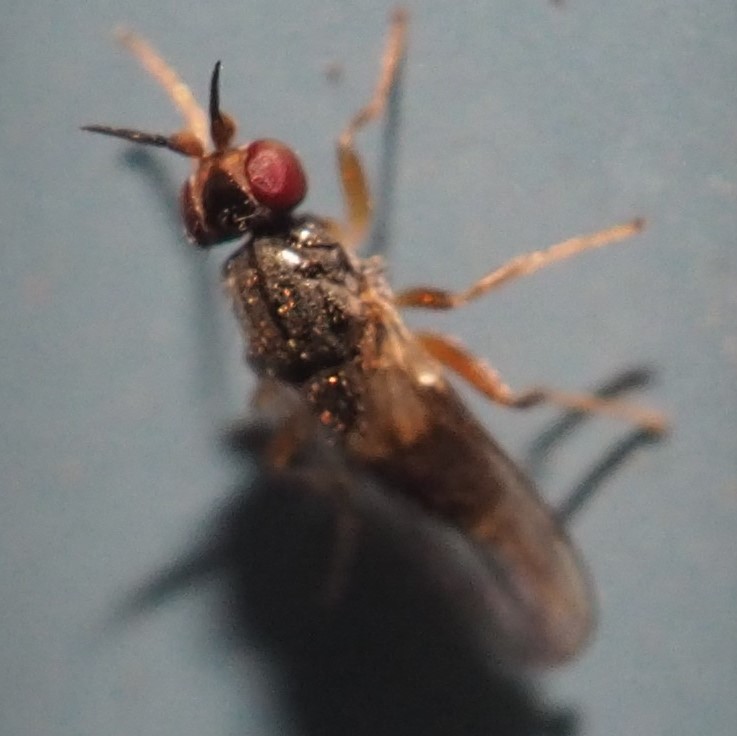
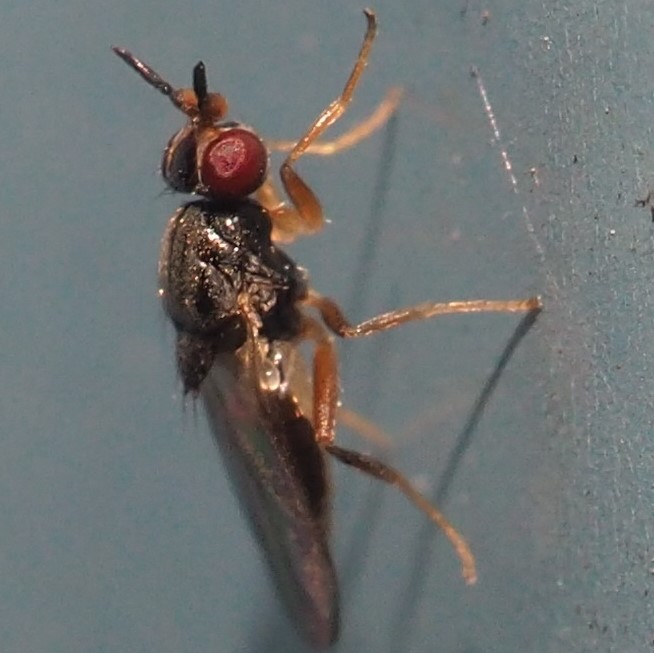
Here is a lovely Lacewing. I thought at first it was a Brown Lacewing, but it is actually a species of Green Lacewing. How about that! Following are a few tiny Moths. That is, I think they are Moths and not just Moth Flies.
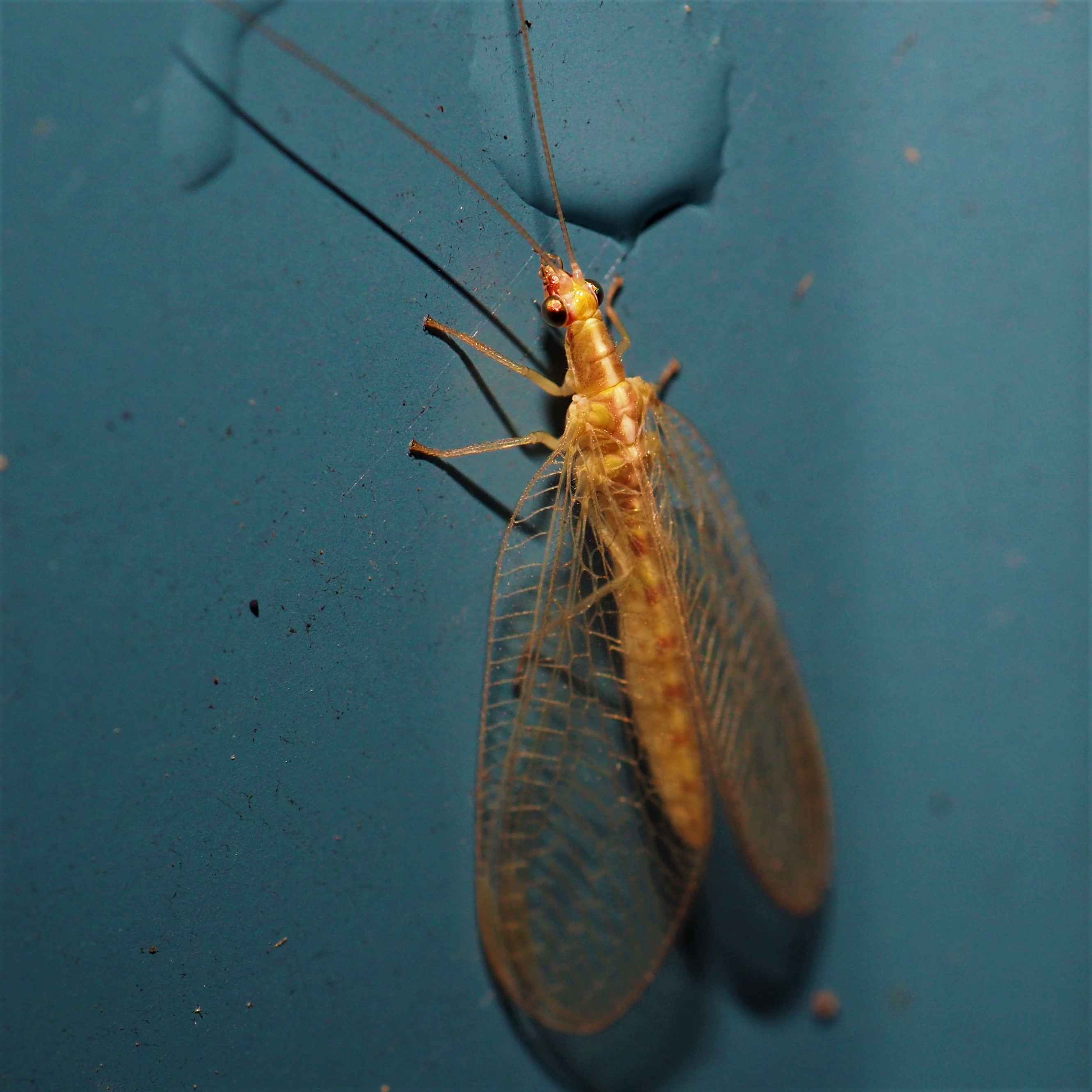
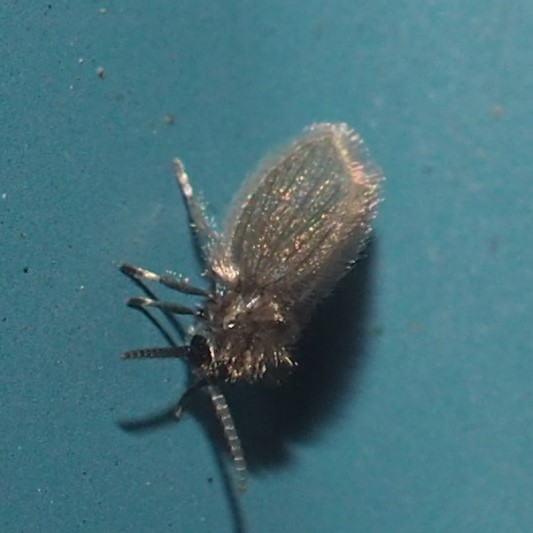
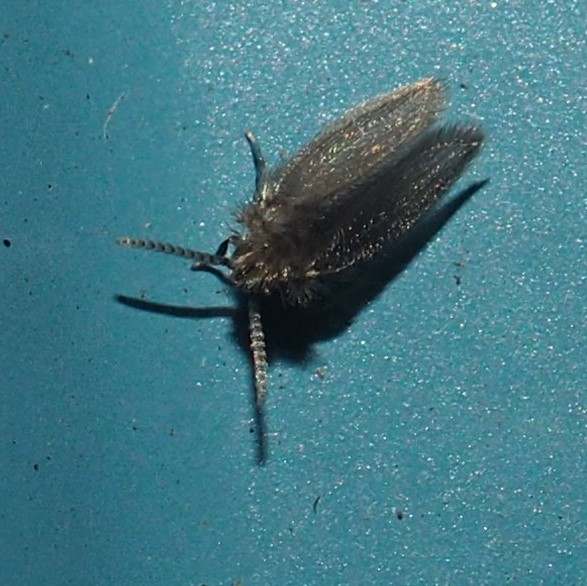
Now this is when we would ordinarily be off on our jaunt across country to see all the flowers. Let's see what we can find that shows up the colors of the season. First is a view of my Sugary Maple (it's not a real Sugar Maple, but makes leaves the color of Sugar Maples elsewhere) next to my next-door neighbors' Maple Tree. Second is a ground-level shot showing the colors on the sidewalks as you look north along my street.
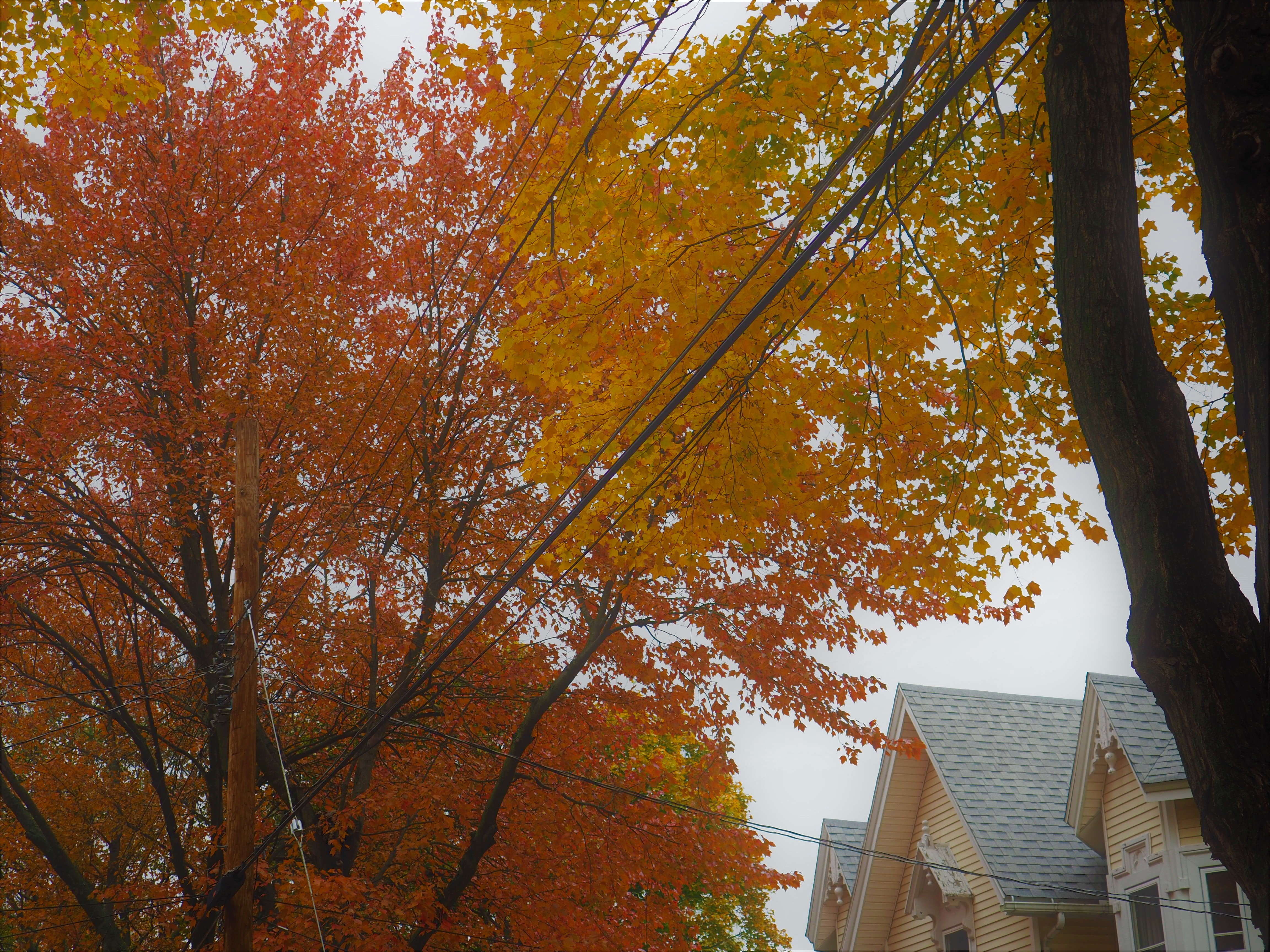
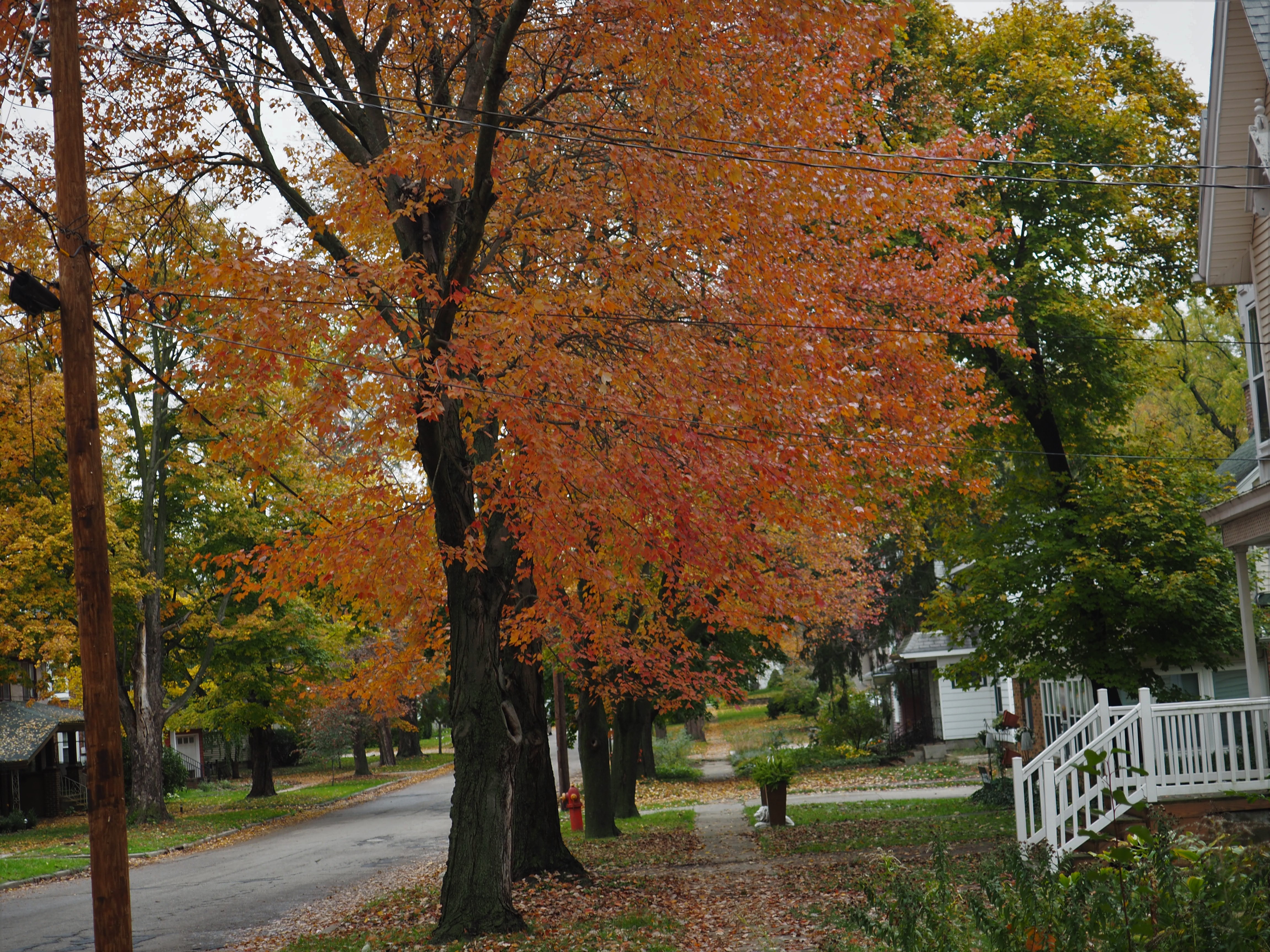
Here is the Euonymus, which was given me by John Hart, the same John Hart as the friend who gave me the start of all the Redbuds in the yard. It has continued to get redder for weeks now. Next you see it next to the house, showing a fraction of the steps leading up to the porch and front door. Please come by - call first!
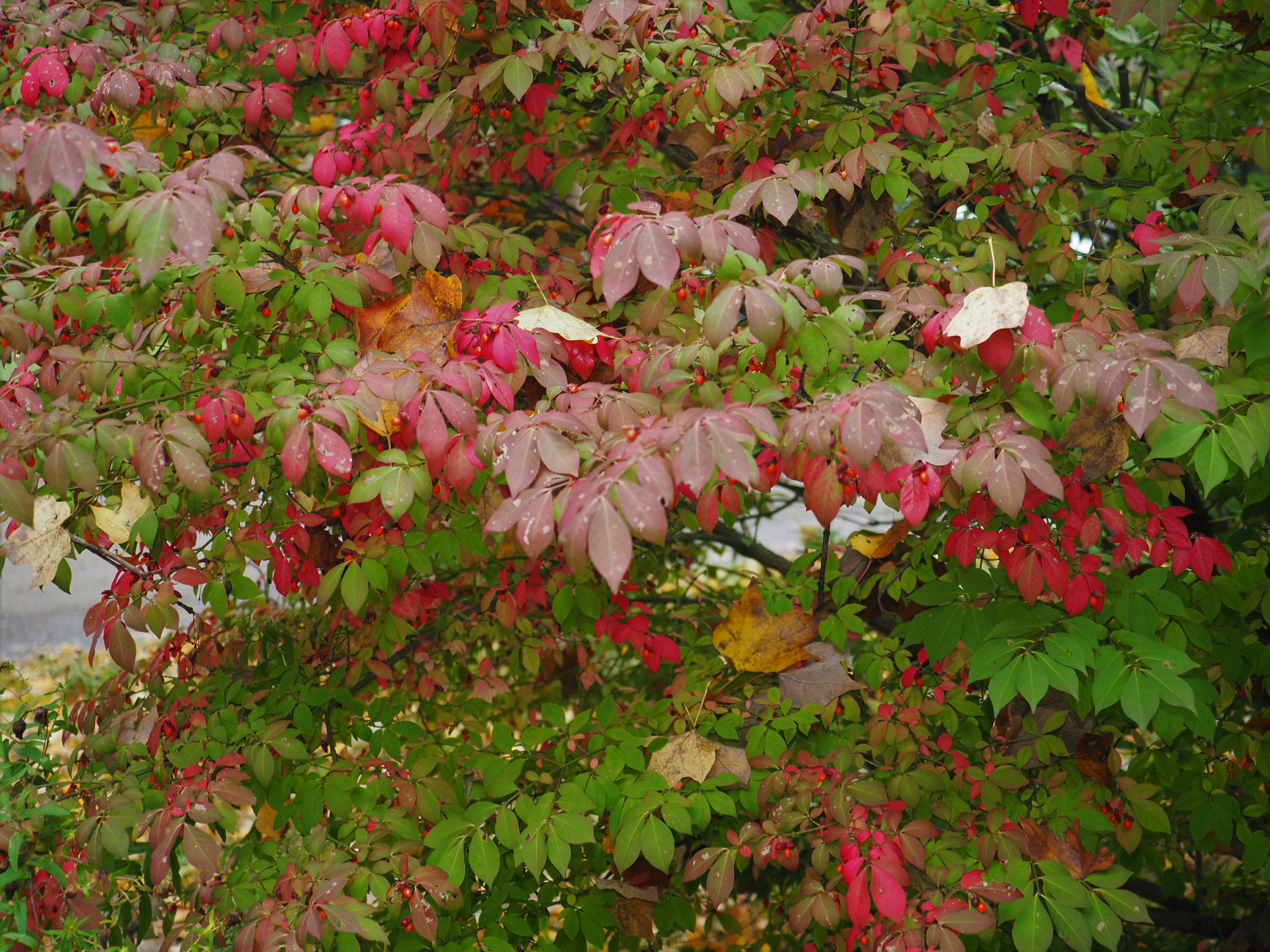
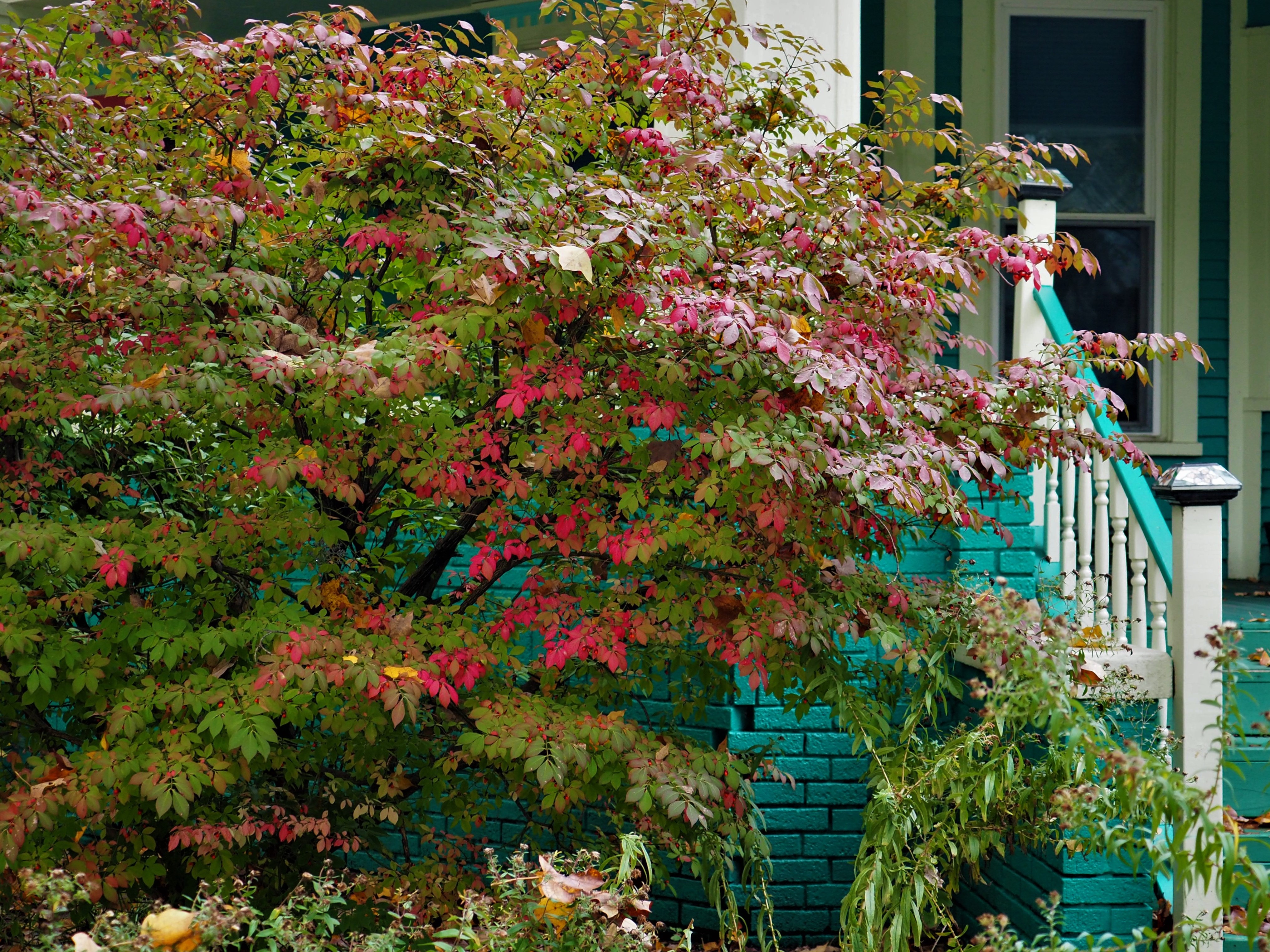
Today's being the deadline for me to find some more color in the yard, I went out and achieved the amazing!
Here was a little group of Fleabane or one of the other tiny Asters in the yard, still blooming! Not a yard, or meter away, was a big pot in which a New England light purple Aster had seeded itself and was STILL blooming! Third, these bright berries are on a strand of an unidentified weed in the front yard. I submitted this picture to iNat and they suggested "snowberries", which makes sense since this was very near a thicket of Snowberries.
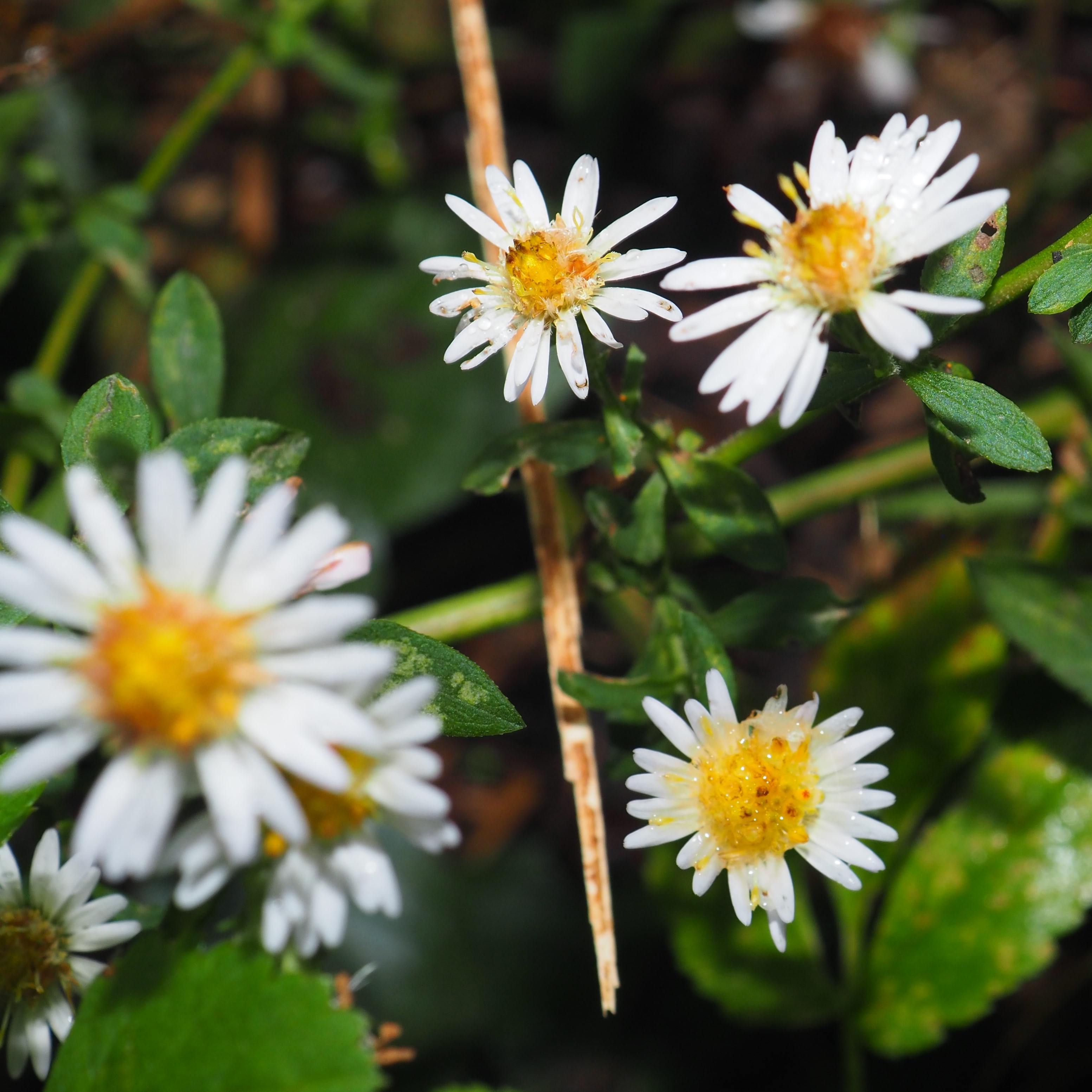

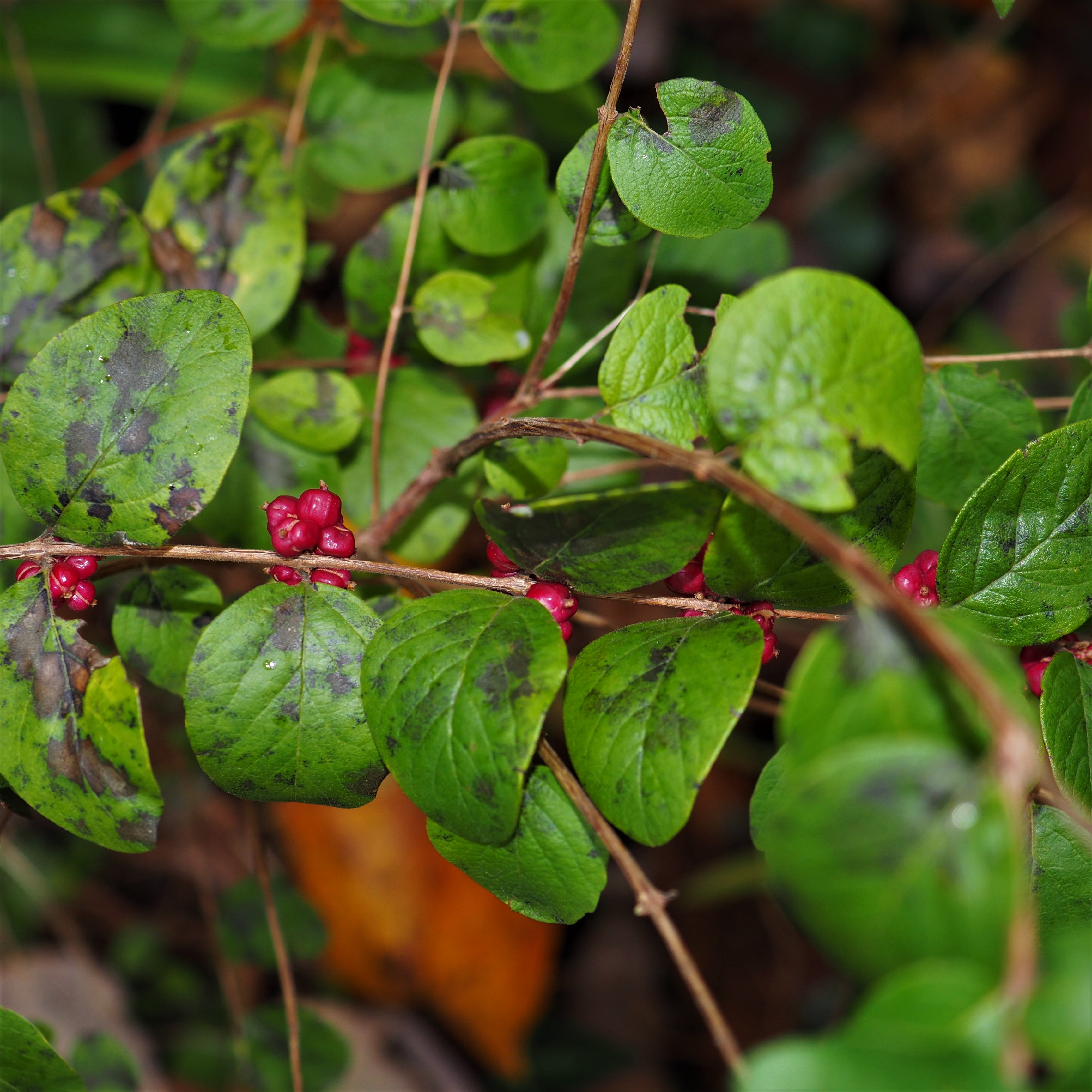
Now for the bad news. The Redbud leaves are quite faded now (pictures 1 and 2). So are the Norway Maples, even though the usual rust spots have long ago turned them UGLY.
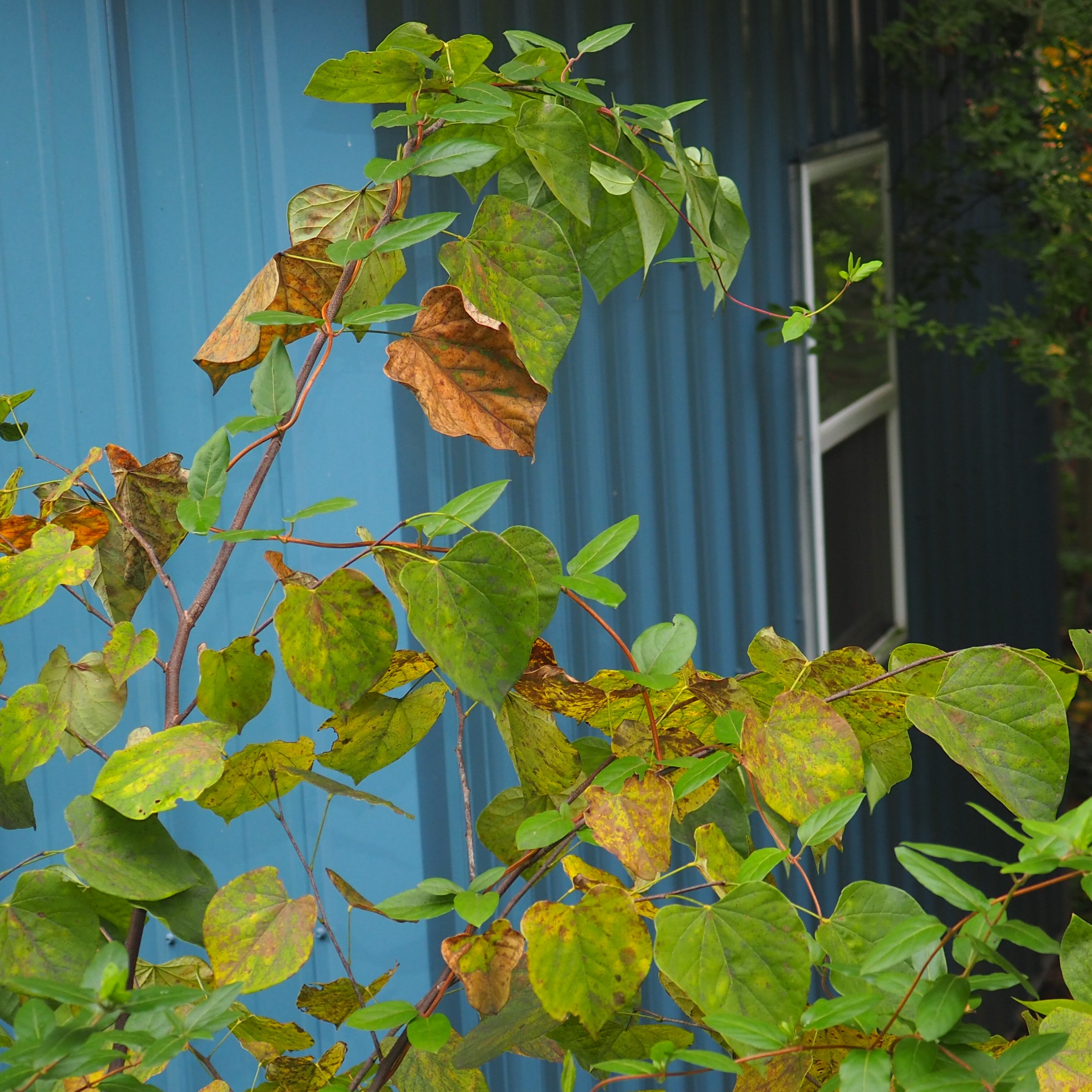
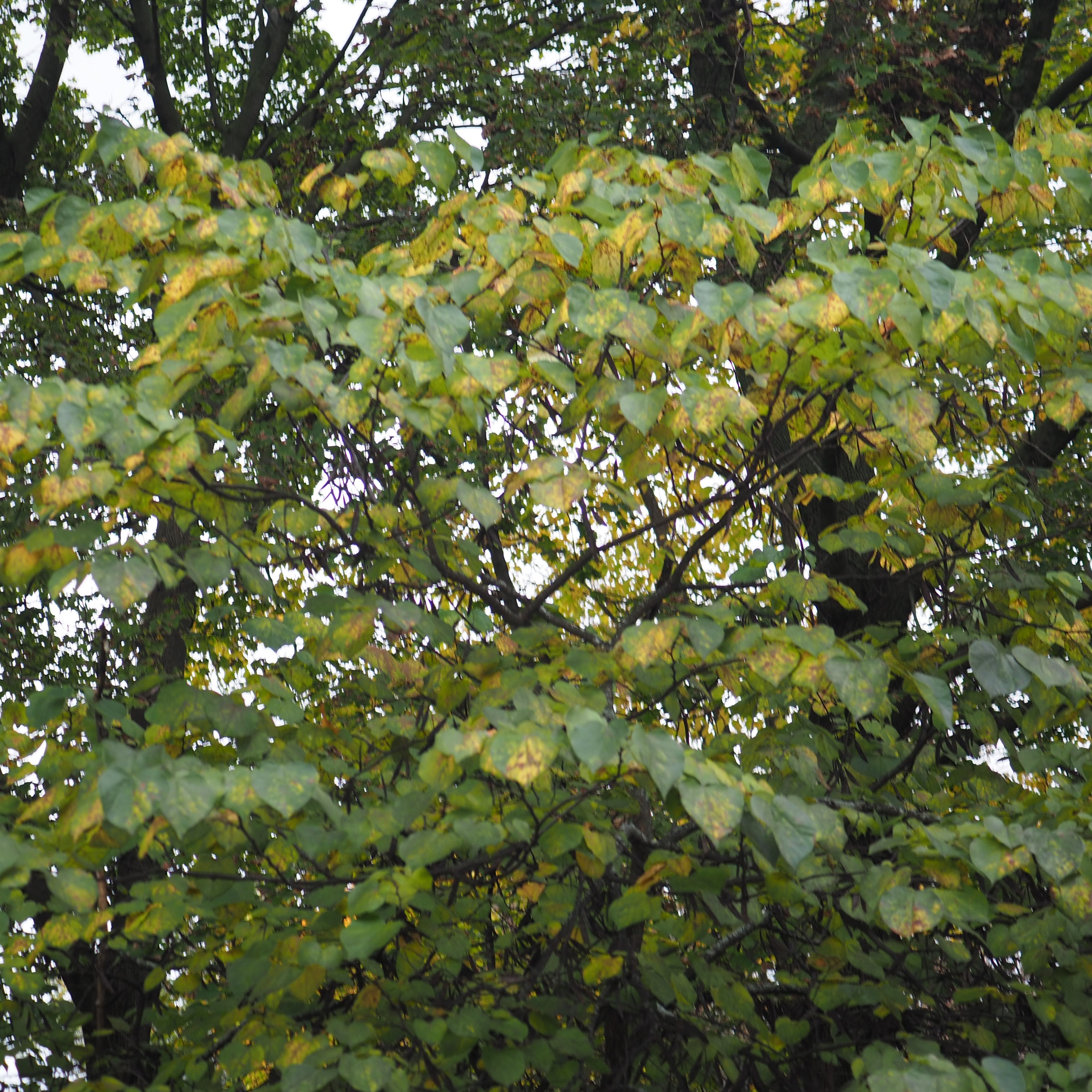
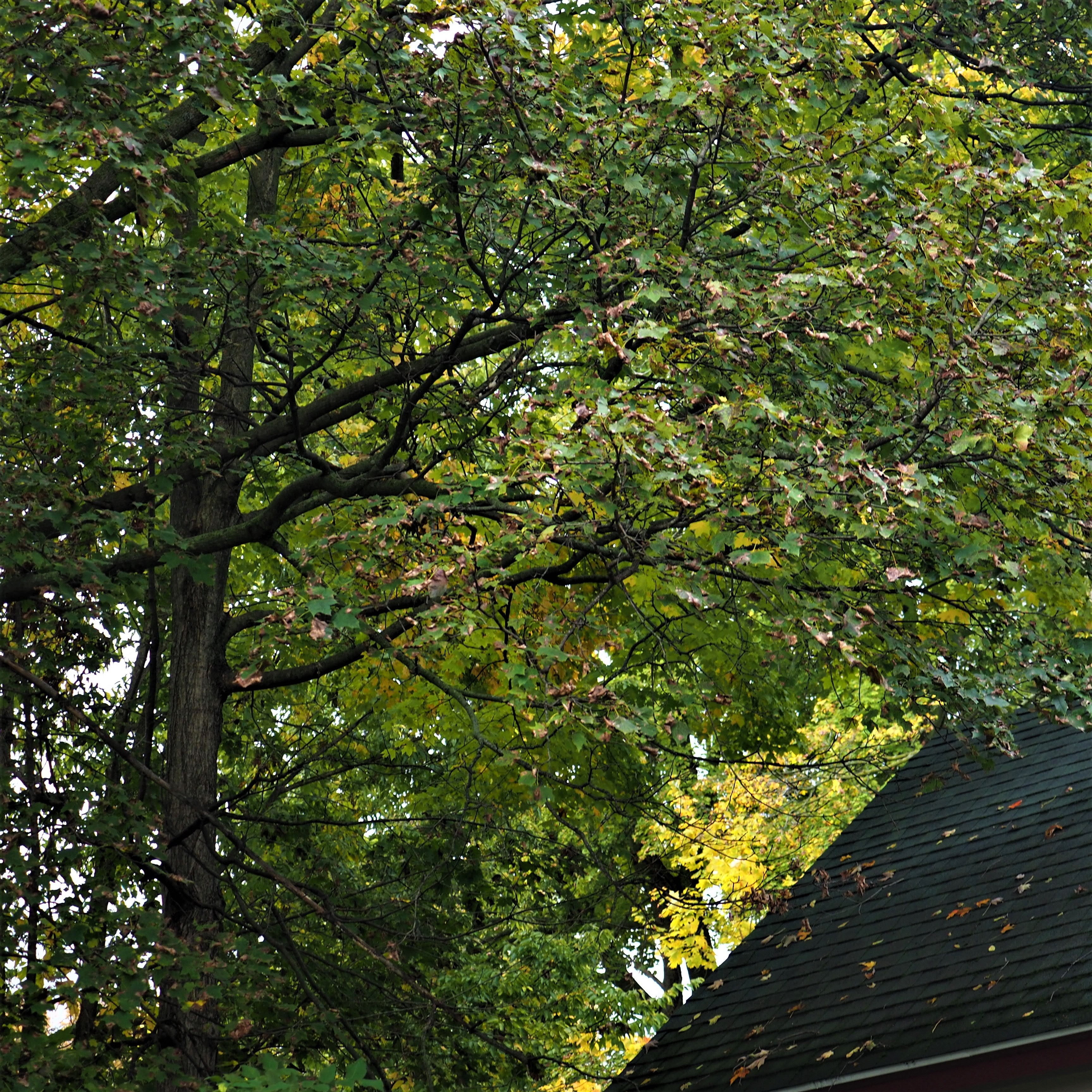
The leaf net (which I finally placed a few days ago) is collecting a good number of leaves. Under it, the fish are now telling me they still want a bit of food, even though the ambient temperature has only been at most in the lower 50's F. Today I sprinkled a tiny amount for them. Picture 3 shows them a couple of days ago, floating parallel to each other low in the pond, becoming a bit somnolescent.
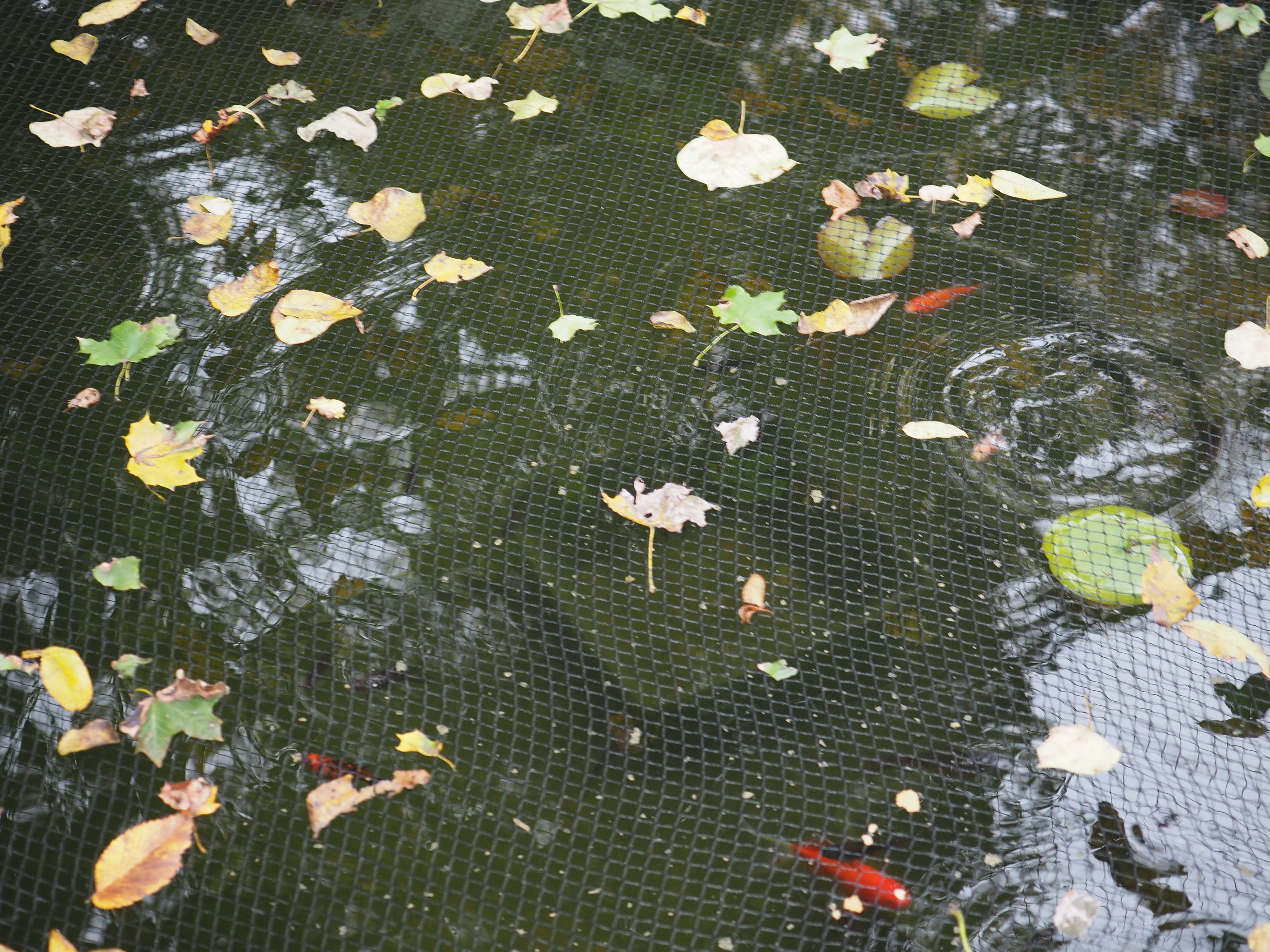
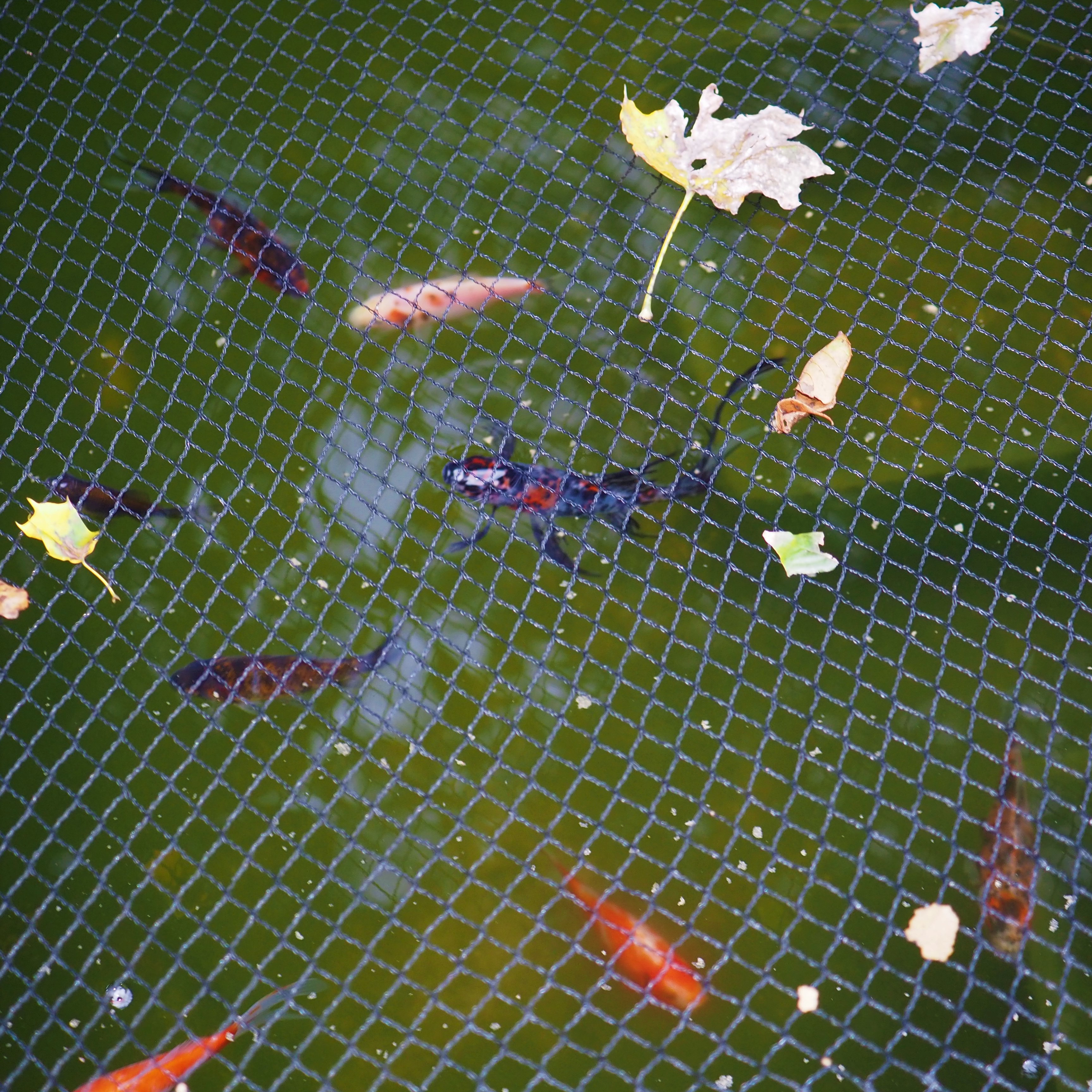
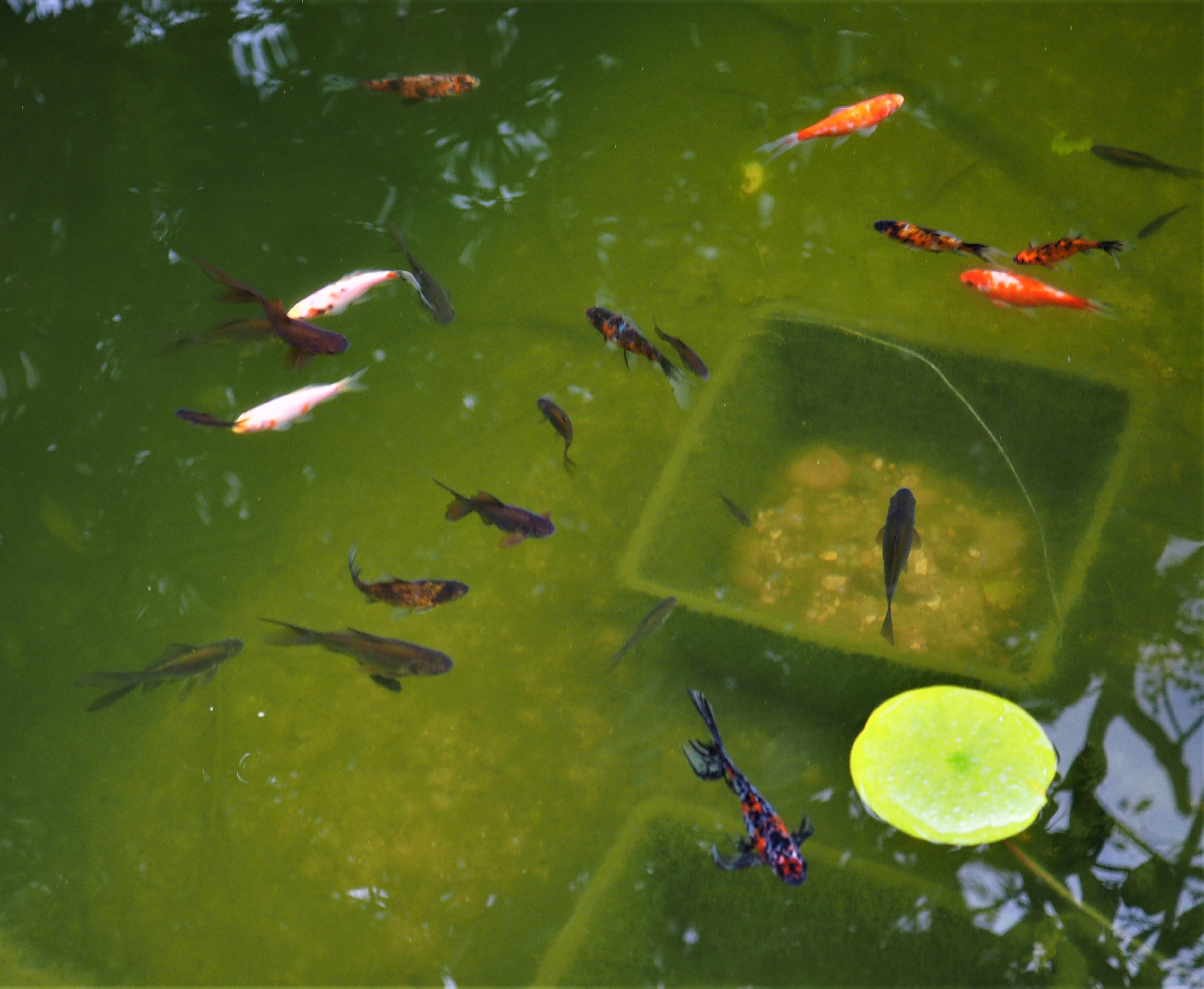
Our dear Jadesy is still out on the deck. I still haven't seen any flower buds - they will stay tightly embraced by pairs of tiny leaves. If you try to peek inside somehow I've never seen them develop. Picture 2 shows some non-flower buds between some of the now larger pairs of leaves. A few more nights can make the mother plant lose leaves and vigor, so I think tonight I'll put a bath towel over her. Picture 3 shows some Jade and some Christmas/Thanksgiving Cactus - It's clearly time to bring those indoors tonight too.


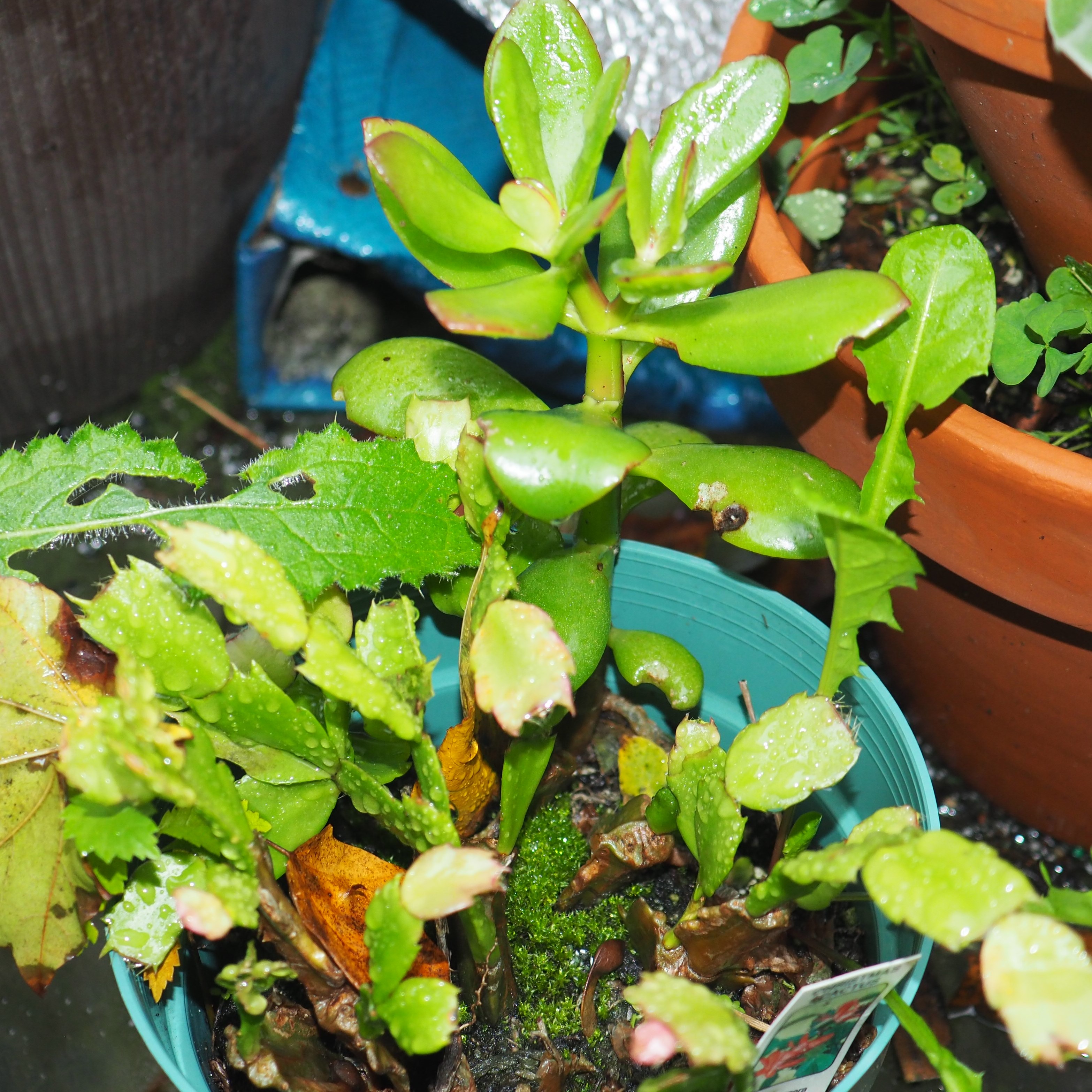
Before the Spiders, here are a couple of Pillbugs that are still active on the North Wall.
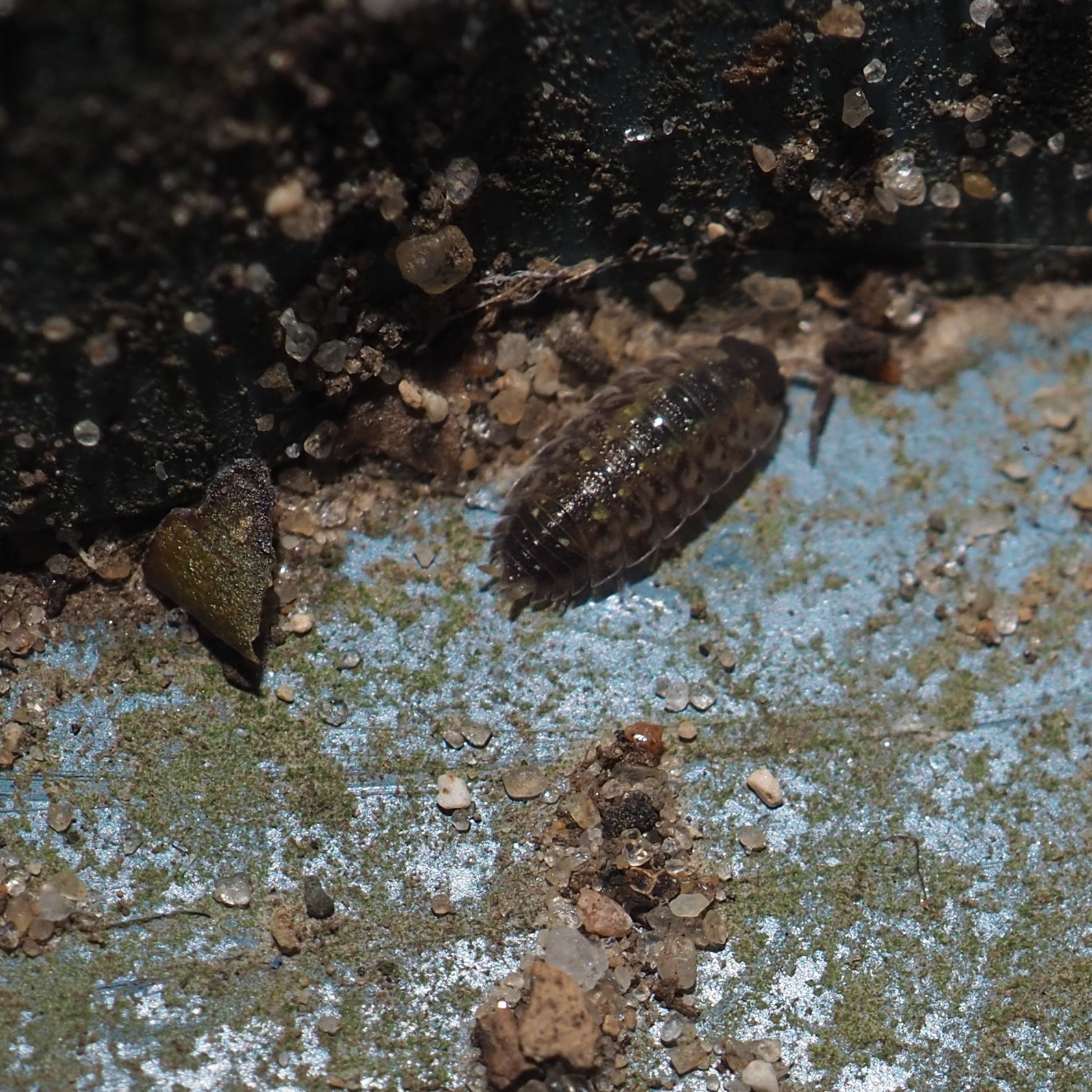
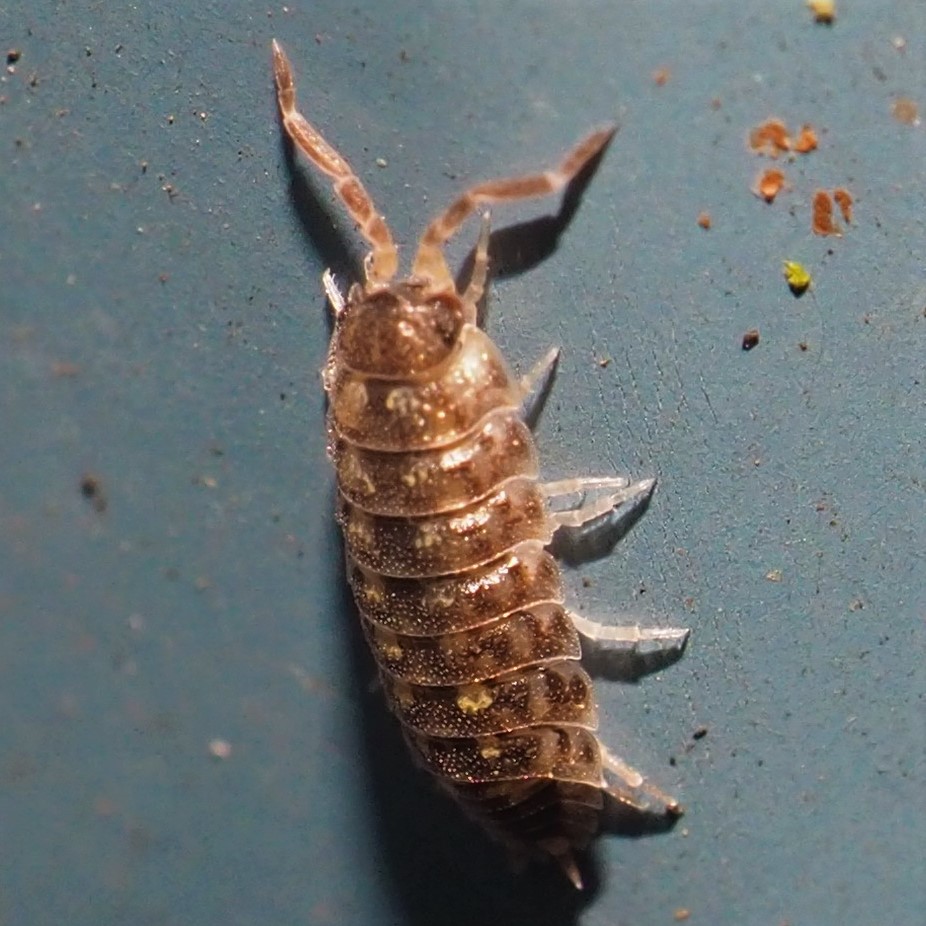
Welcome to the World of Spiders. The number of kinds seems to be down a bit. Most of what we see now is Common House Spiders. One of the scenes we discussed last week was this spider that had caught a larva of some kind of other creature. But now I'm convinced that the Prey is actually the Larva of a predatory wasp, probably an Ichneumonid or Braconid Wasp, and that the Spider is actually the Prey. This identification was made by two members of iNat, @kimberlietx or Kimberlie Sasan and @tz_nh, who goes by her handle. This third little Spider is probably a Cobweb Spider.
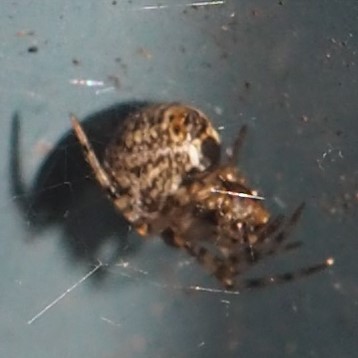
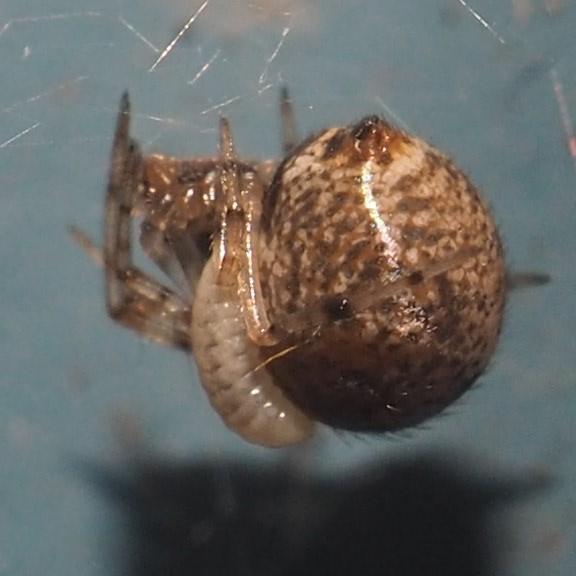
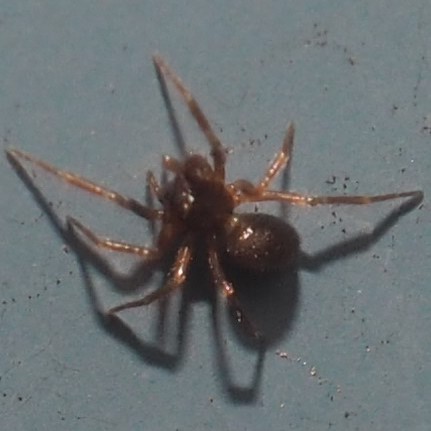
Turning to Wasps, we had this one little Ichneumonid Wasp, which is very hard to identify, there are so many of them. Sorry!
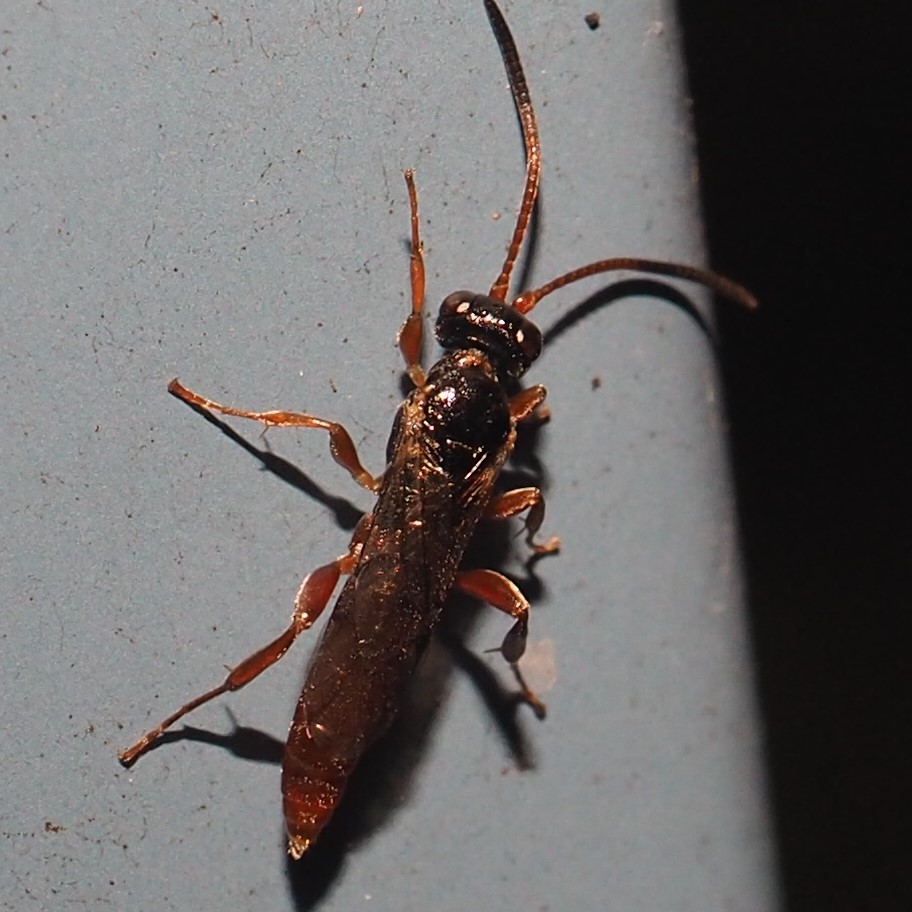
I think we deserve a nice view of the Pond as it was in 2015 and as we hope it will be again soon!
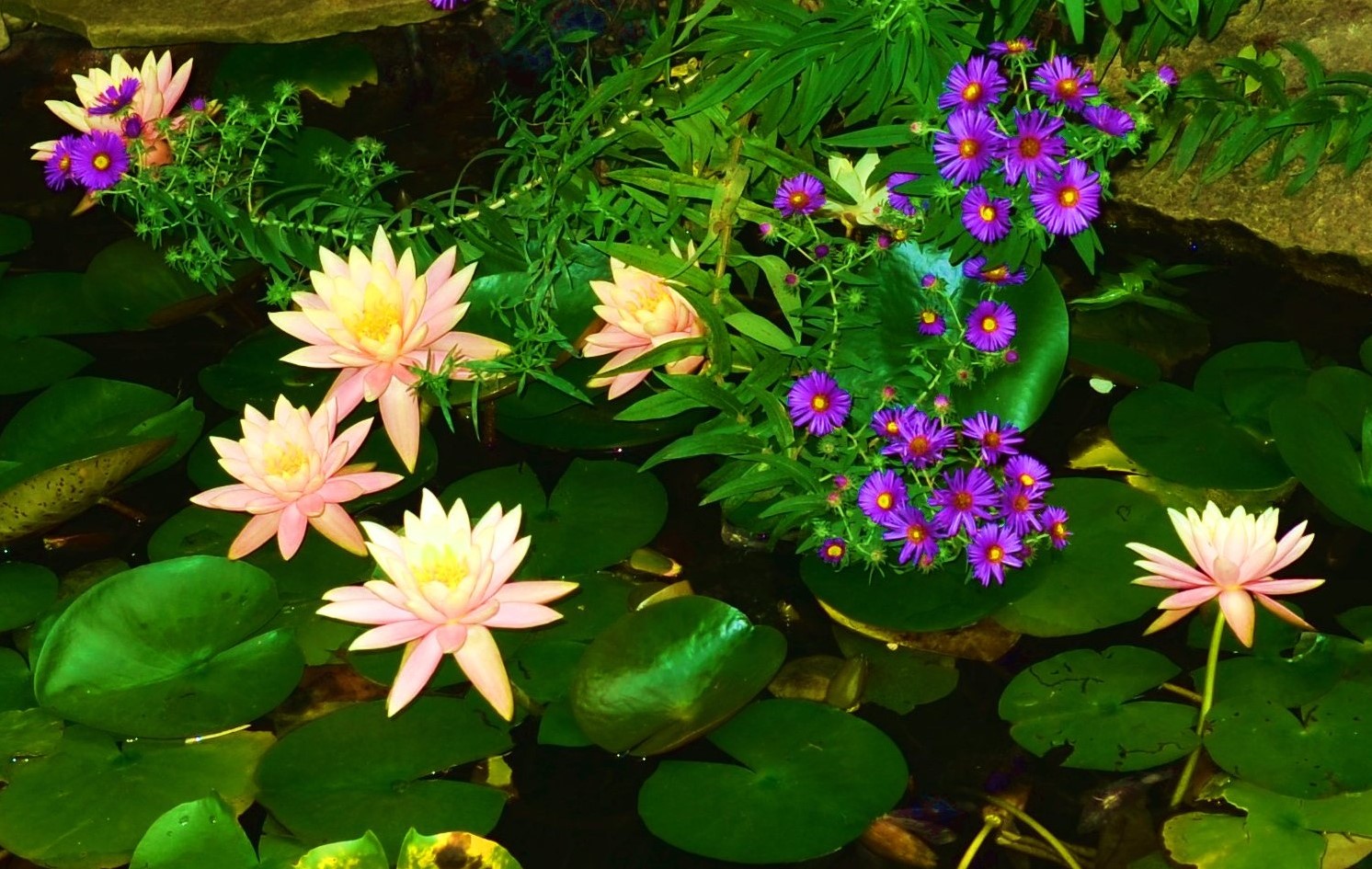
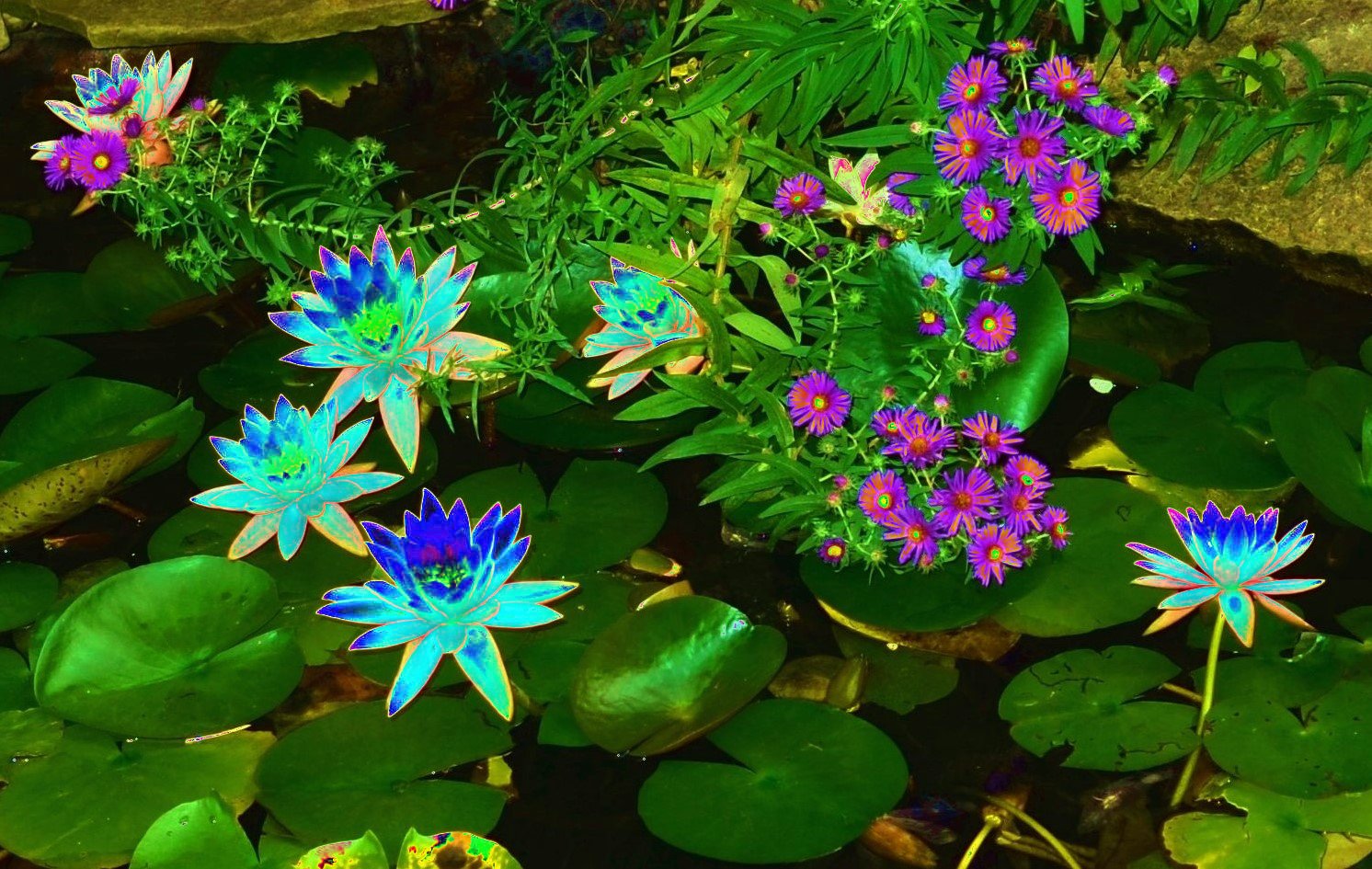

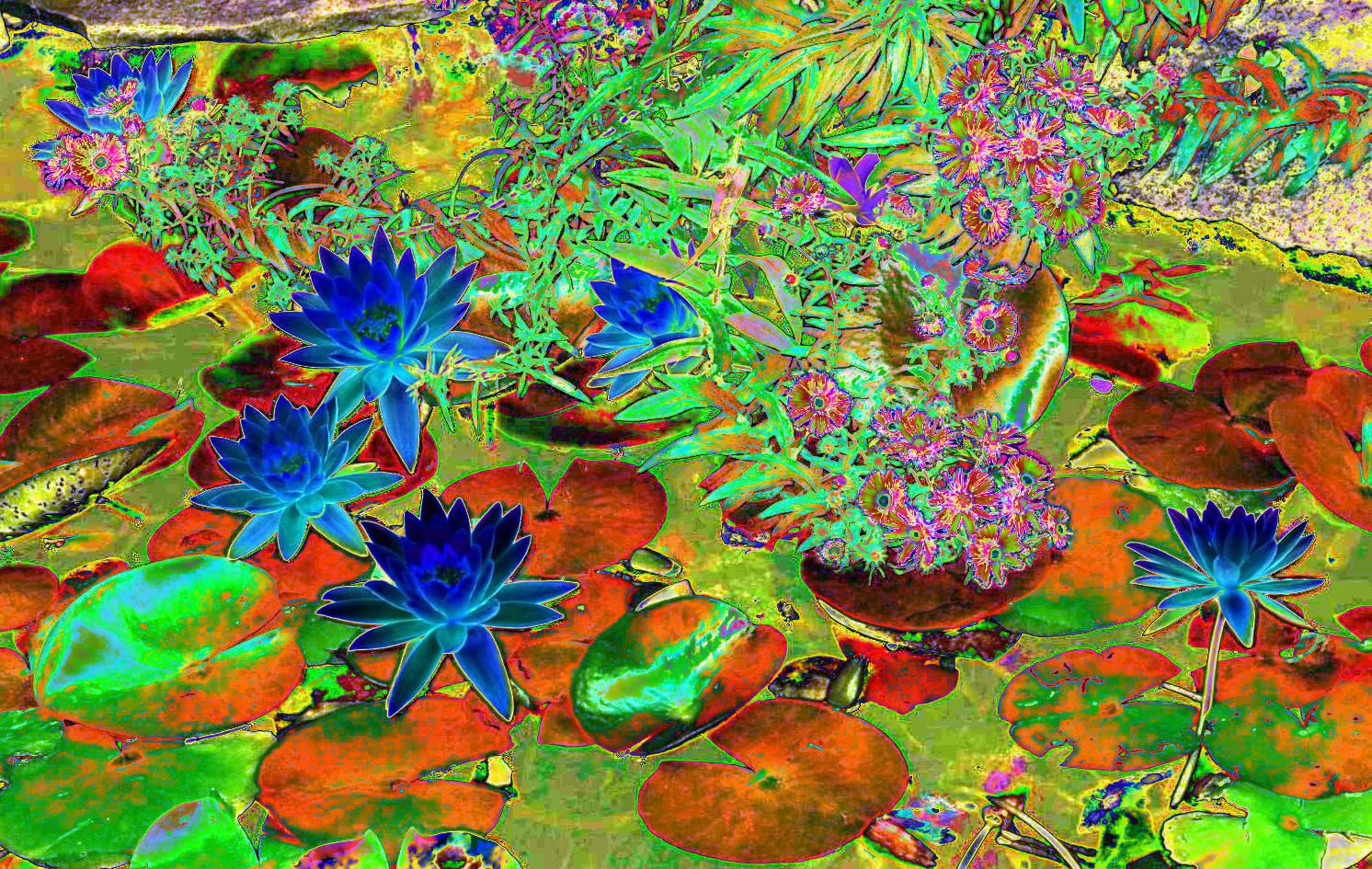
The October term of our Albion Area Lifelong Learners is over. But that doesn't mean life is at a standstill. Not a bit. What do you do when you have a half moment's still time? Just as we were finishing the last leg of the October term, one of our beloved members, Sparry Sparks, died suddenly. We send all our good wishes to his wife and friends. I'm constantly reminded of how all our best plans can be suddenly changed, and how resilient we are forced to be. I wish for all of you all of the best kind of life we can have. Now I have some yard work to go do before supper. I'm sure you do too.
Love, Martha
Aside: By the way, you may have noticed I've been trying to involve you in a game. Maybe you remember all you learned in school about poetic meter. A number of you have declared your love of iambic pentameter - if not, take out your Shakespeare and read a line or two. Here's an example: I wish that I could meet the Bard again. Now you try it. You can email me a short example. If your favorite isn't iambic pentameter, write your line (or lines) in your favorite (and tell me what it is). You may have found a message in the email I sent this blog in! Hint: it will either be in Haiku or Iambic Pentameter.
Back to October 24, 2021
Forward to November 7, 2021
Back to main menu
copyright Martha O'Kennon 2021























































































